Editor’s Note: This article was originally published in Overland Journal, Spring 2014.
In Punta Mariato, the southernmost point on continental North America, the mud is deep, and the rivers are flowing. It is also only accessible by a serious four-wheel drive or motorcycle. The distal and disparate points for a place like Punta Mariato on a map have great appeal to me as a traveler; they are unique and nearly always difficult to reach. However, challenging routes are not limited to end-of-the-earth destinations. Other fantastical places like Mayan ruins, ancient castles, and bubbling volcanoes are dispersed throughout the world, but to explore beyond the beaten path we need a capable, reliable, and durable vehicle. For this test, our team abused, jumped, overloaded, and pushed the best dual-sports on the market well beyond where the majority of owners will ever take them.
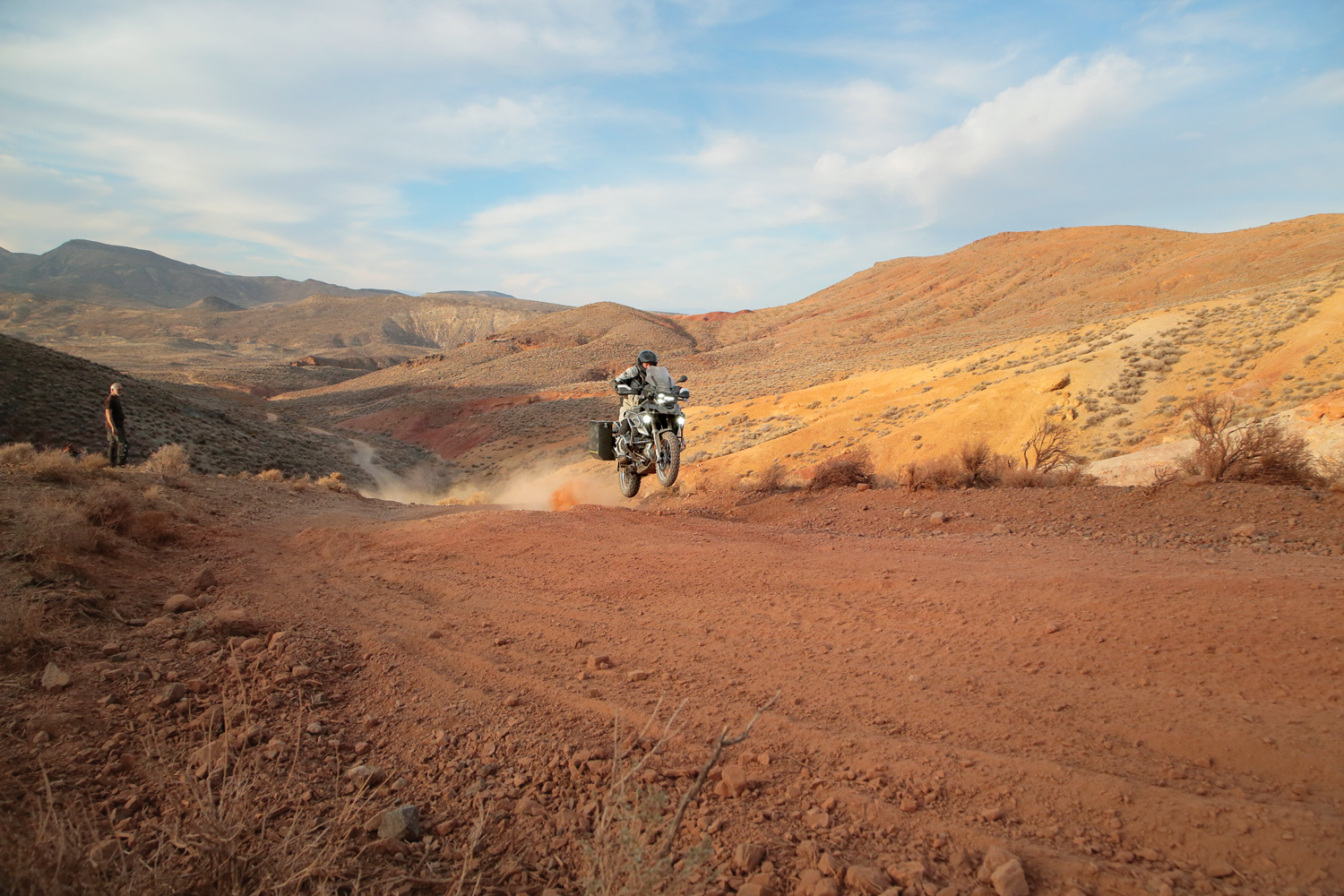
When I left Panama City in Spring of 2009 for Punta Mariato I chose a KTM 640 Adventure fitted with a set of healthy knobbies and enough fuel range to get through 100 miles of nasty, muddy track beyond the last petrol station. While many “adventure” riders want a touring bike that looks adventurous, I believe true backcountry performance is one of the most important attributes. If the goal is adventure, a motorcycle must be comfortable to operate in a standing position, have sufficient suspension travel, a large front wheel, be durable, and able to carry the load for an extended journey. It must be capable of navigating river crossings, rocky washes, and deep sand, instilling rider confidence while doing so. Once a traveler leaves the predictability of the first world, any and all of these conditions can exist…even on the same day.
For this review, Overland Journal focused on full-size bikes in the 800cc to 1200cc range. This is not to say that smaller bikes are not a legitimate option. In many ways, they are better, particularly on bad roads or in congested traffic. But for now, we have big bikes on the brain and have partnered with Rawhyde Adventures to gather six of the best options in the category.
Testing and Considerations
The motorcycles presented here have been ridden for months or years by our team, and in a wide range of conditions. For the final segment—a handlebar-to-handlebar comparison—all six were collected in California for a weeklong pounding in the Mojave Desert and Death Valley. The KTM 1190 R Adventure, due to its recent release, had slightly abbreviated testing here. However, after the Mojave/Death Valley slog with the other bikes we took it to Baja, Mexico, for several more weeks of real-world testing in a variety of terrain.
In typical Overland Journal fashion, this is not an ordinary review. We elected not to evaluate stock bikes fitted with street tires and fragile plastics exposed. Instead, each bike was modified in nearly identical configurations, enhancements that included knobby tires, skid plates, crash bars, and luggage. Performing similar modifications allowed for uniform evaluations, and the increase in performance and protection allowed evaluators to push the bikes well beyond the safe confines of a gravel road or press launch (we believe that most “shoot-outs” are not only too short but also too gentle). The bikes were dropped, some were crashed, all were jumped (Jeremy LeBreton from AltRider is responsible for any images with both tires in the air), and nearly all got stuck. We can also assure you that each of the bikes have been pushed hard and for enough miles to reveal any weaknesses. As the primary evaluator, I was most interested in critical performance attributes and expedition-biased specifications.
Field Evaluation
Rawhyde Adventures provided the motorcycles, performed modifications, and coordinated travel logistics and accommodations which allowed for concentrated back-to-back riding. The trip started at their facility in Southern California and included miles of interstate travel, where we evaluated horsepower and torque, highway cruising characteristics, and comfort. The route then shifted onto smooth gravel roads where traction control, stability, and ABS were assessed. Deep sand followed, where more bikes crashed or got stuck than made it, including my embarrassing 40-yard duck walk through a dry wash on the Super Ténéré.
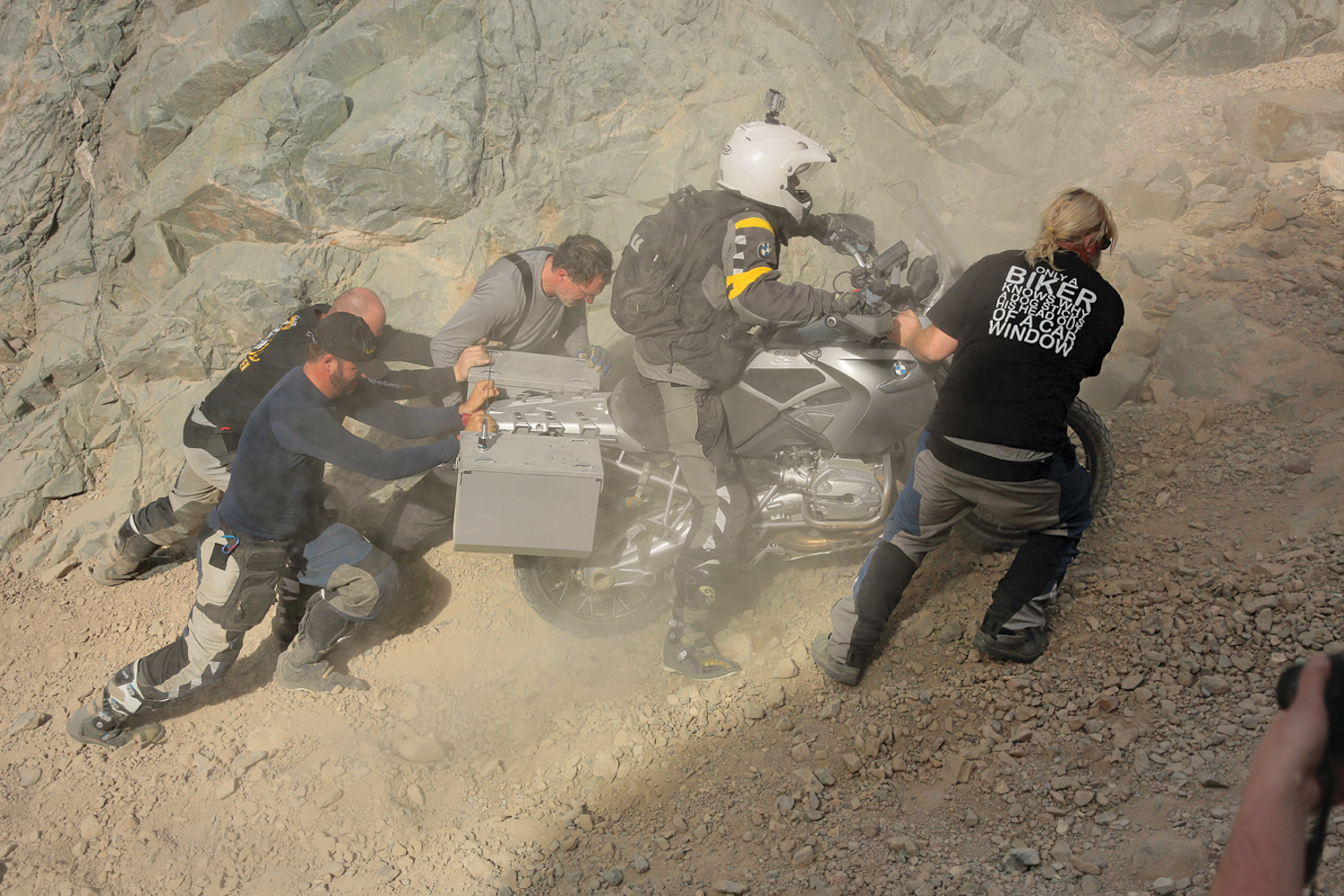
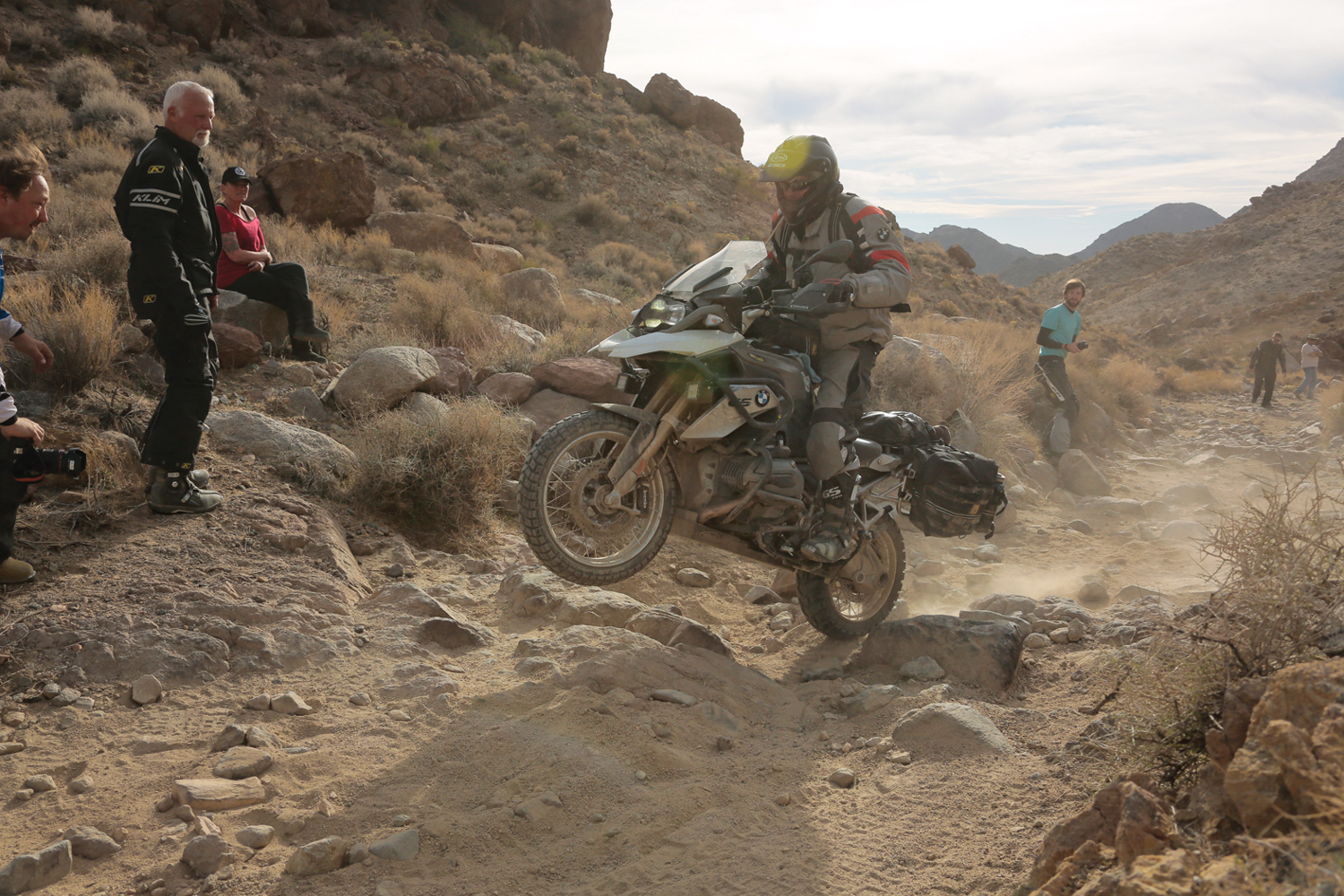
Near the town of Trona, California, we encountered numerous hill climbs, then back-to-back flogs on a series of jumps and ledges. After an evening of camping at Rawhyde’s Base Camp Alpha we headed east toward Death Valley via Goler Wash and Mengel Pass; both technical routes. In the valley, we navigated miles of sandy, rocky, and rutted tracks. By the end of the week we’d spent 5 nights camping, pushed through 6 days of dirt riding, and covered hundreds of miles on two-lane paved roads.
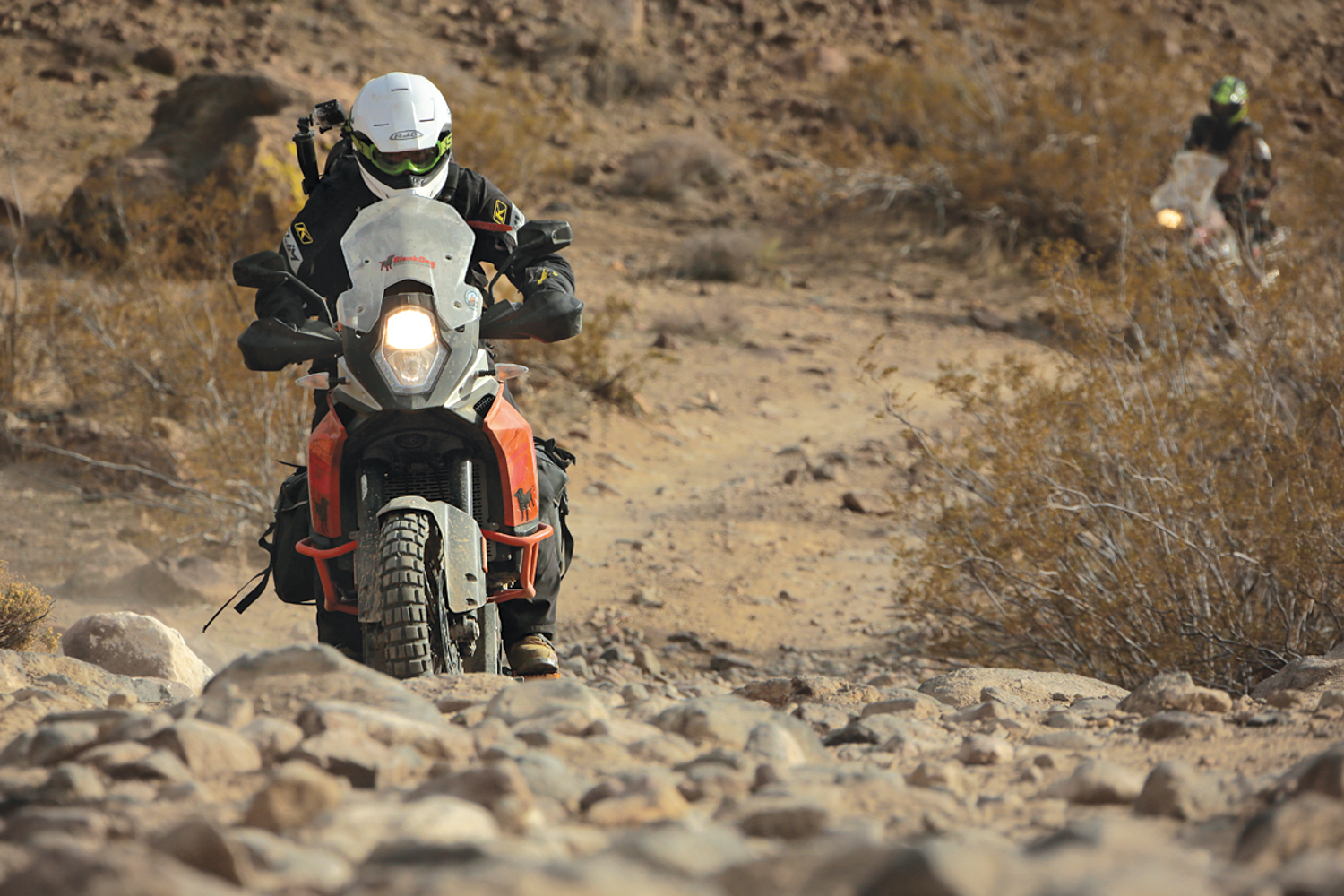
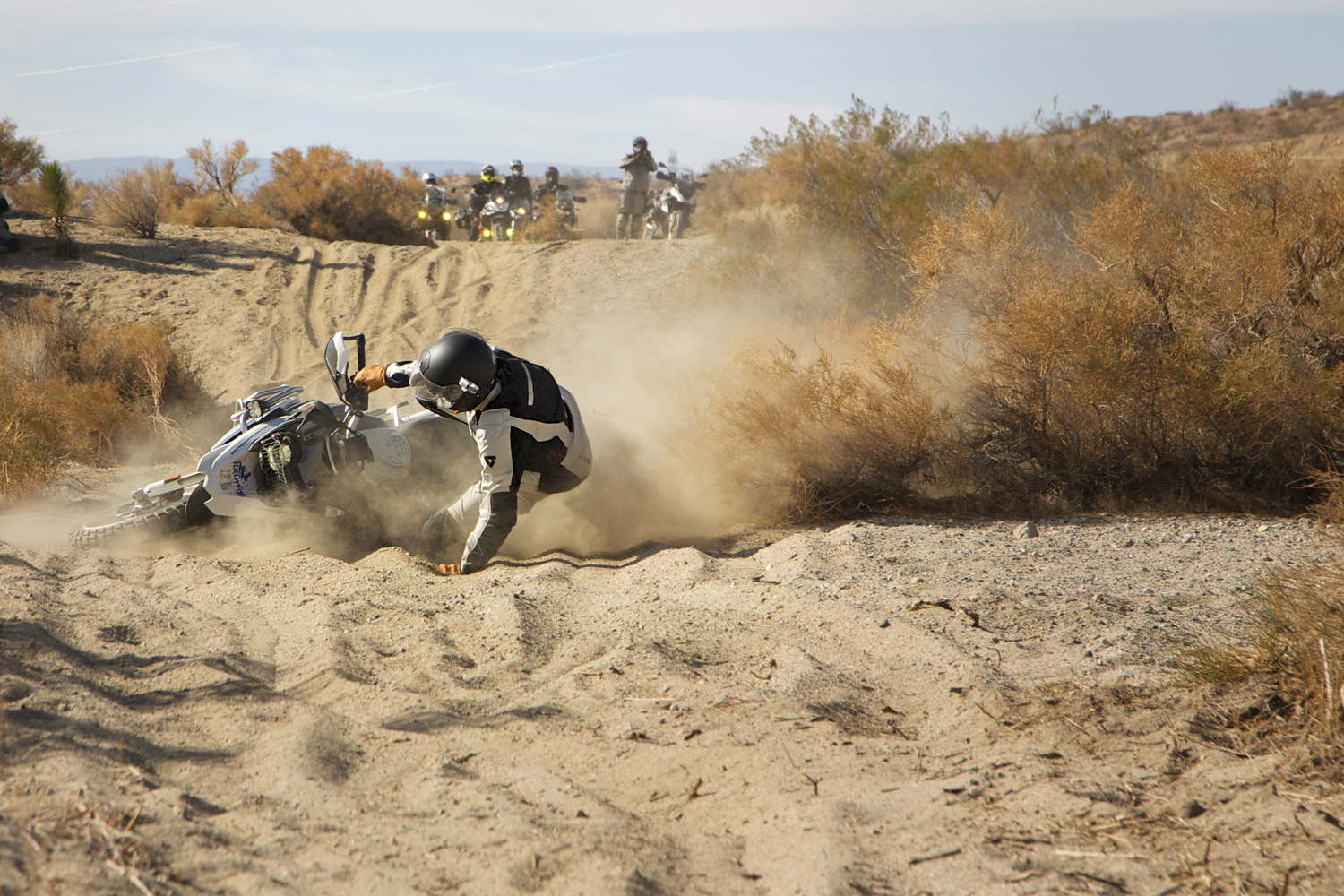
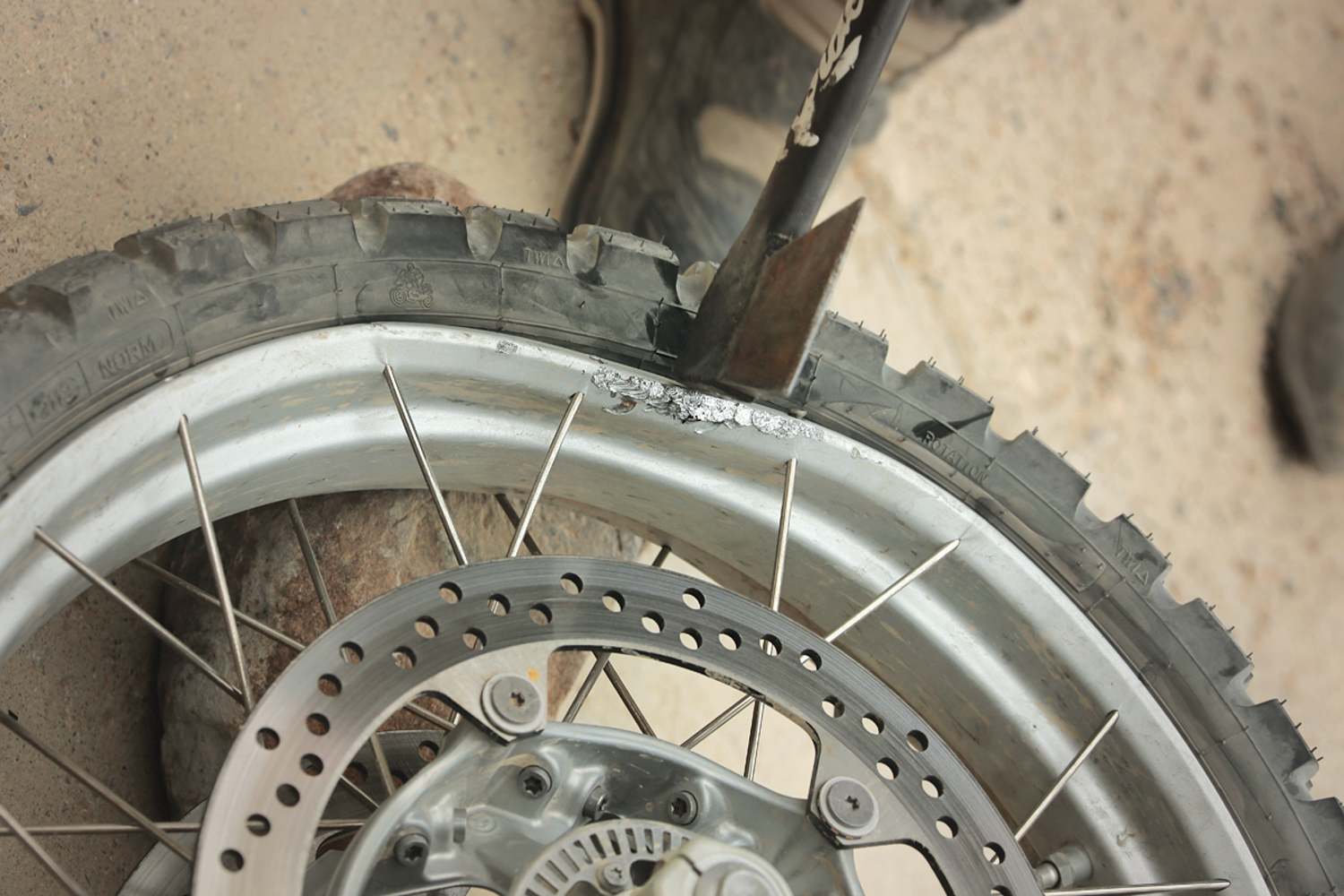
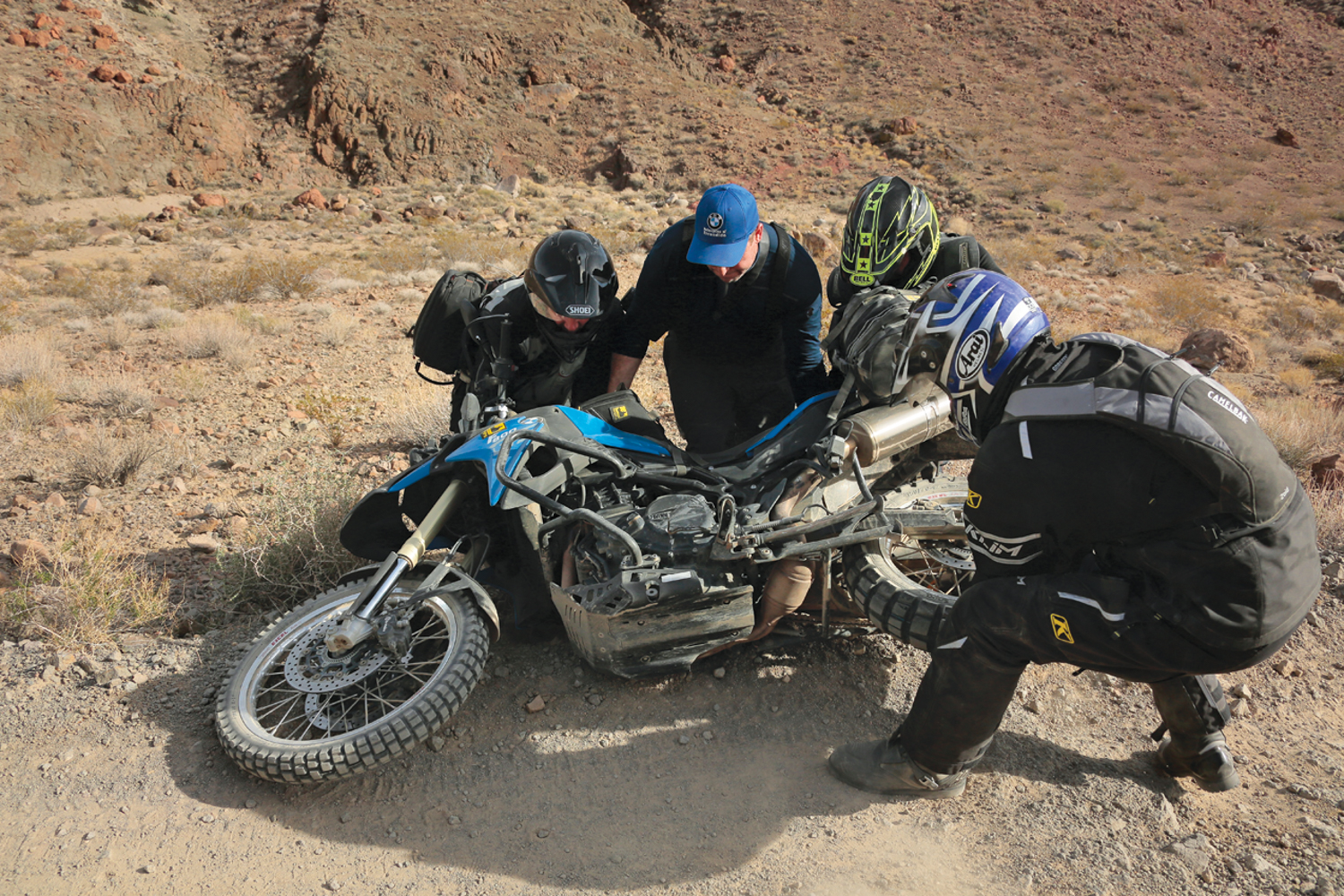
BMW F800GS $12,090
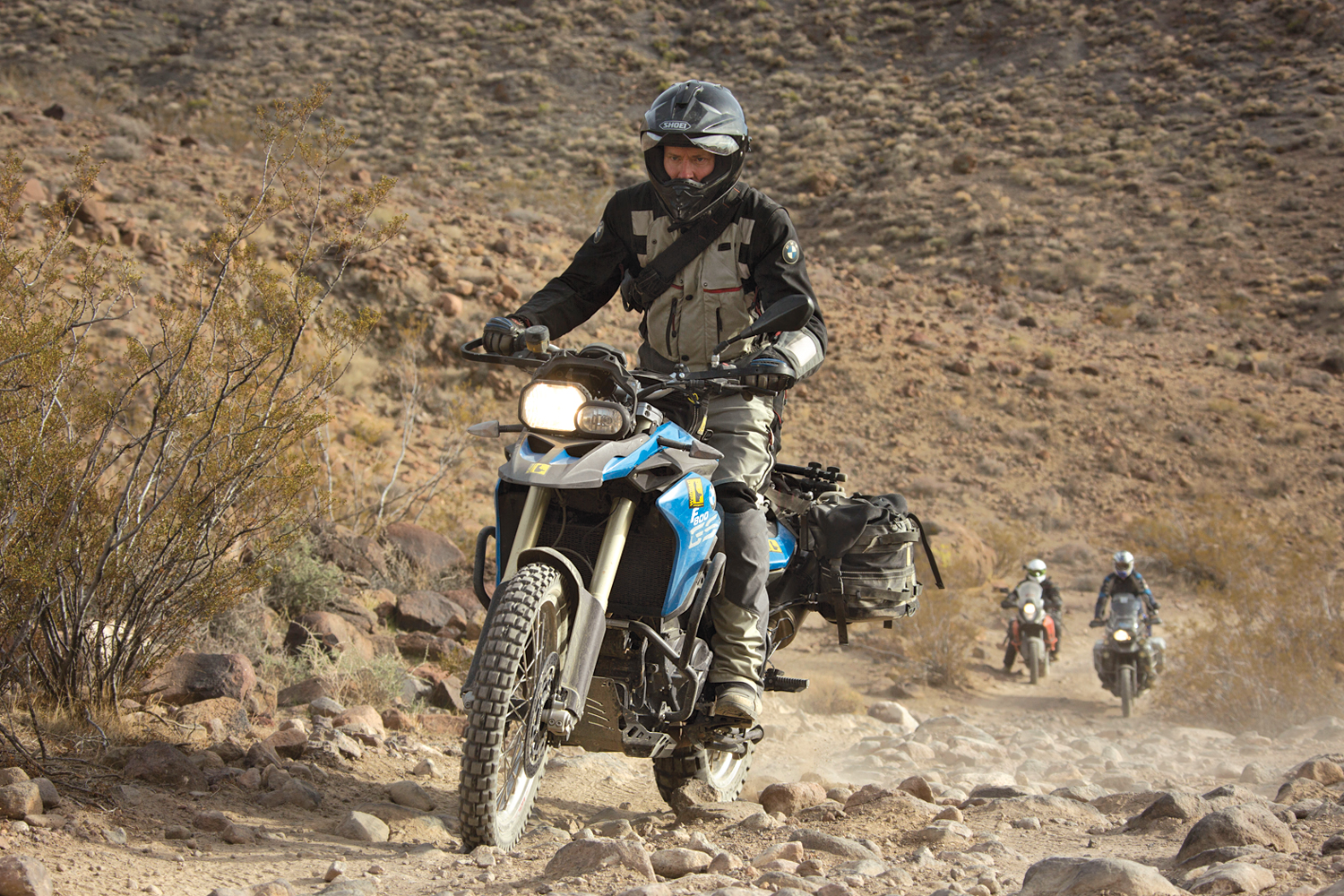
The F800GS was launched in 2008 to significant anticipation and applause. With a 21-inch front wheel, upside-down forks with over 9 inches of travel, and legendary BMW design and build quality, it was an exciting new model on paper. Unfortunately, the momentum slowed as the model suffered from a range of recalls and reliability issues.
On Road
On the highway, the F800GS is pleasant to ride, with sufficient power to pass and cruise at the legal limit. Power delivery and handling are more refined than the previous variant, and the brakes received a major upgrade. Though this model is great for commuting, proving to be nimble and responsive around town, I would describe the 800’s road manner as adequate, but ultimately uninspiring. The other issue we discovered was pronounced head shake, particularly with the knobby tires.
On Trail
On the trail is where the F800 earns the GS badge, providing better than average performance. The large front wheel made it easier to manage rocks and ledges, and improved flotation and control in the sand. At 472 pounds this is a heavy bike, and the soft suspension struggled to control the heft of metal and rider. The wheels have also proven to be fragile and soft, which is evident once an expedition load is added and the unexpected pothole arises. However, this doesn’t detract from the slight dirt advantage it has over the larger bikes (KTM excluded). Gearing works well and is aided by a wet clutch and the modulation it provides. The ABS system can be deactivated and in general the F800GS handles well in dirt. Though the 4.2-gallon fuel tank is small for extended travel (our observed 58 mpg yielded a disappointing 240-mile range), BMW offers a 6.3-gallon tank for the 2014 Adventure model.
Overall, I felt the F800GS suffered from average performance and build quality. Short of its dirt attributes, it falls below the R1200GS in performance, quality, and refinement. This fact is made more compelling once the price is considered, particularly in Adventure trim, where ASC, ESA, heated grips, and center stand are optional. Our conclusion is that the F800GS is a nice-looking bike, but reliability issues and the aging platform make other models more attractive.
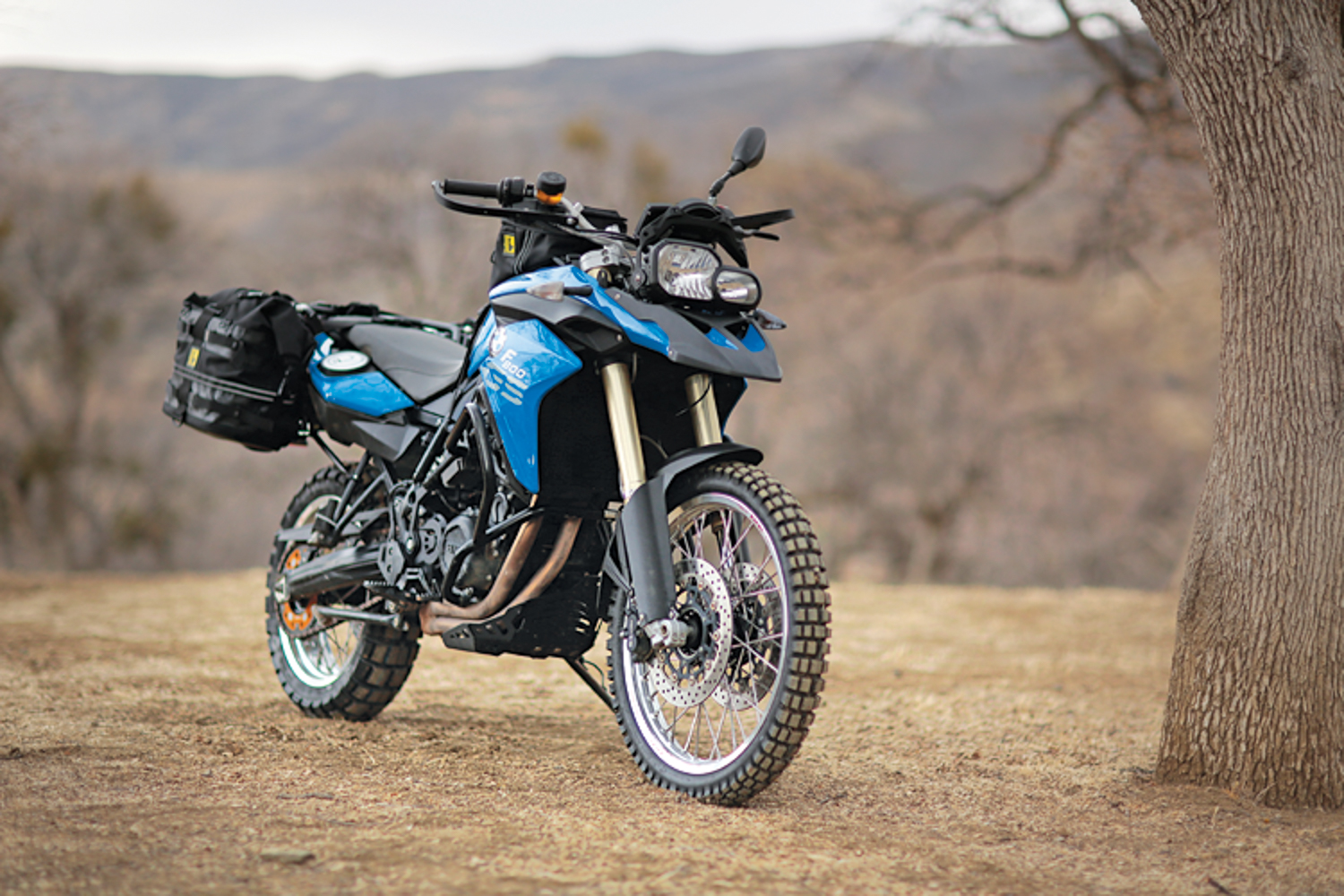
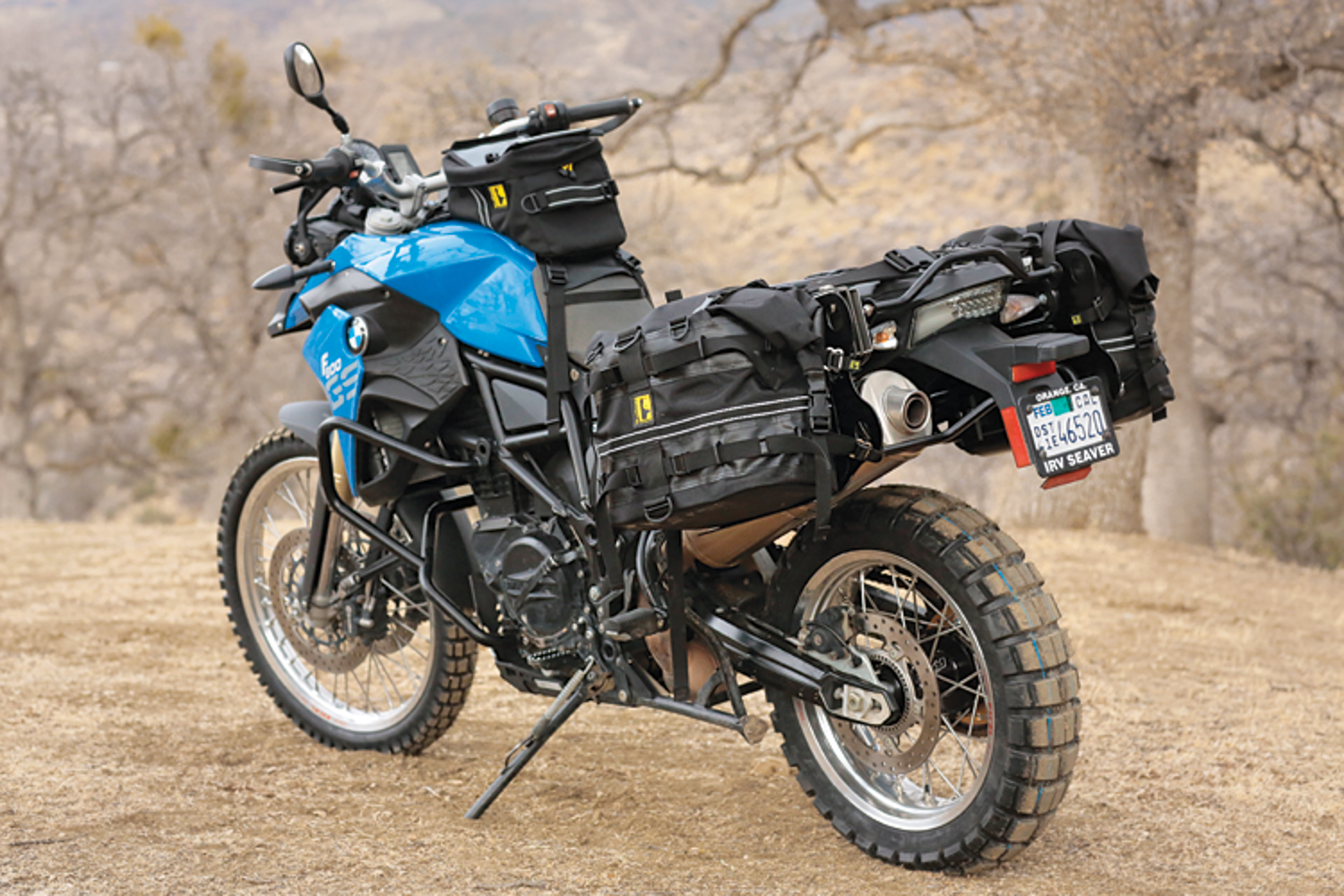
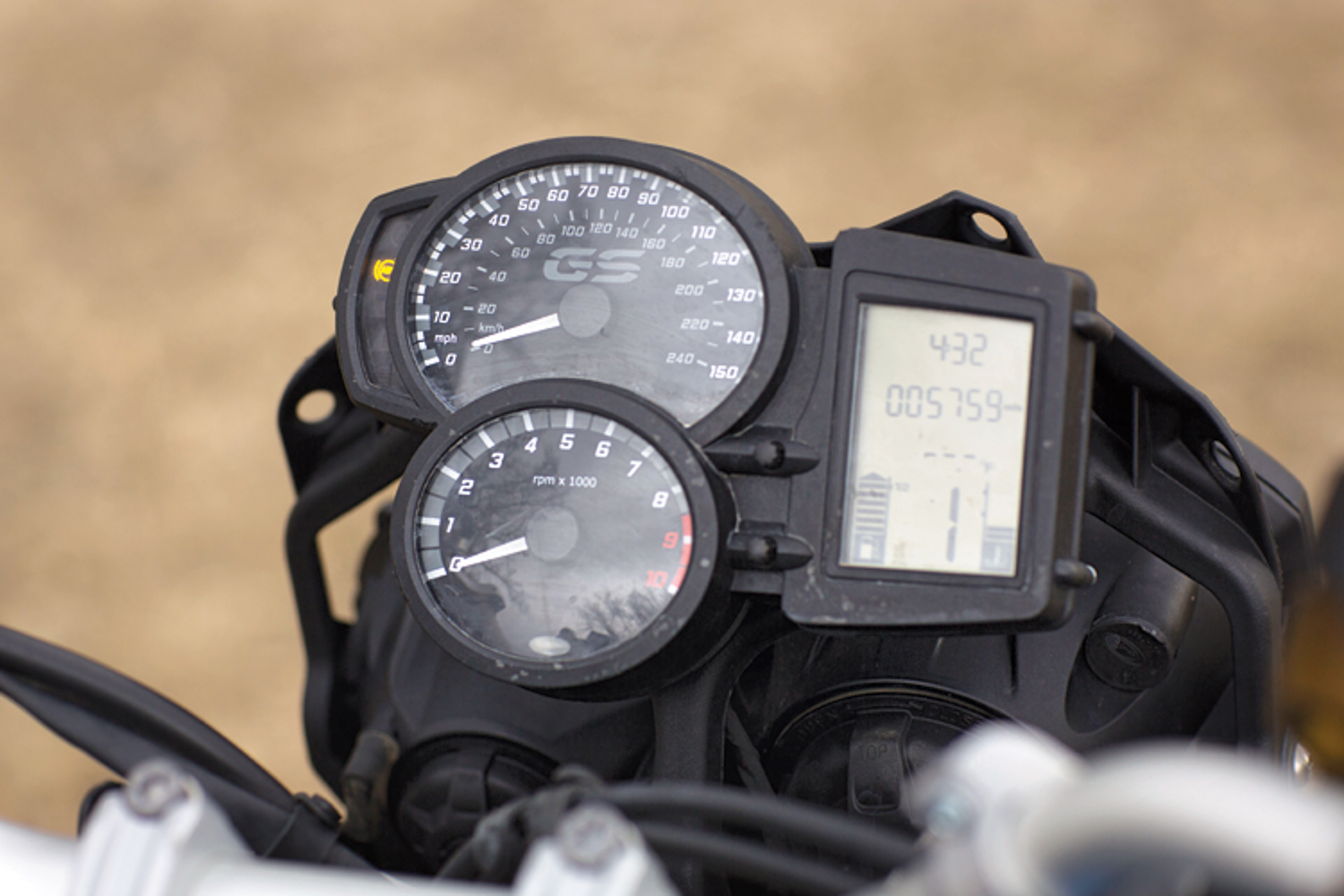
Pros:
• 21-inch front wheel
• Good suspension travel
• Class-leading payload rating
• Lightest bike in the review
Cons:
• Numerous reliability issues
• Rearward weight distribution results in awkward handling on- and off-road
• Poor observed fuel economy for engine displacement
BMW R1200GS $17,735 (as tested with ESA)
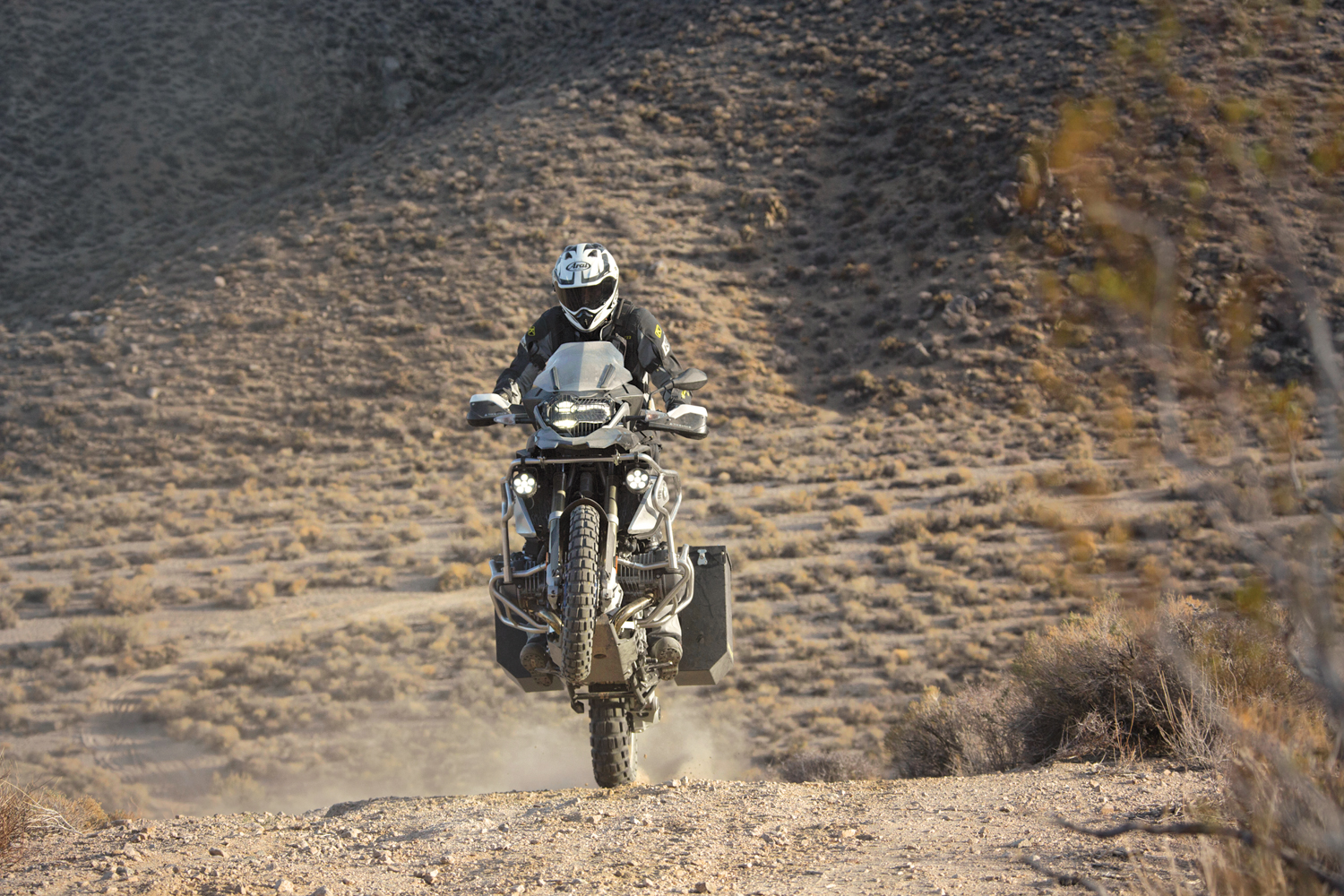
For over 30 years the BMW GS has been the standard in adventure motorcycles, striking a critical balance between comfort, touring, and off-pavement performance. It is generally loved and respected around the globe, and for good reason. I have spent a lot of time with the new water-cooled GS, and put thousands of dirt and pavement miles on a stock unit, even riding from Cartagena, Colombia to Lima, Peru on one.
On Road
Without question, the R1200GS is the most refined touring-worthy motorcycle in this test. The new motor is smoother than the previous model and the additional 25 horsepower adds to its cruising prowess. The seat is excellent, and ergonomics are supremely comfortable, enhanced by the adjustable windscreen, wide bars, cruise control, and integrated navigation control. Though rider position is fairly upright, the GS feels supremely stable while cornering. Cruise control might seem unnecessary, but we’ve found that a few miles of relief improves the enjoyment of long rides. The heated grips go to full nuclear setting and hand guards do a good job of deflecting wind and rain. My only complaint is the ridiculously small numbers on the speedometer; reading them takes concentration away from the road.
On Trail
The R1200GS is impressive in the dirt (defying its size and weight specifications) and instills confidence. While it’s easy to pin the positive evaluation to intangibles, I believe this is owed to its low center of gravity, centralized weight bias, and wide peg position and bars. ABS and traction control, in both the Enduro and Enduro Pro modes, are extremely effective, and precision suspension tuning provides smooth rebound and limited bottoming. Balance and control in moderate terrain are excellent, but there are limits. The challenges are its overall weight, ground clearance, and the 19-inch front wheel. The bike’s limits, however, particularly with an experienced rider, are shockingly high—even rocky single-tracks can be negotiated with patience and skill.
The R1200GS is stable, capable, durable, has class-leading refinement, and is without question the most comfortable motorcycle in this review. The windscreen does an excellent job of controlling noise, and the cruise control reduces rider fatigue. The Enduro Mode, traction control, ABS, and wet clutch provide solid dirt performance, and the addition of knobby tires and a skid plate will get you through. It looks great and has modern styling, yet nods to the legacy of the brand.
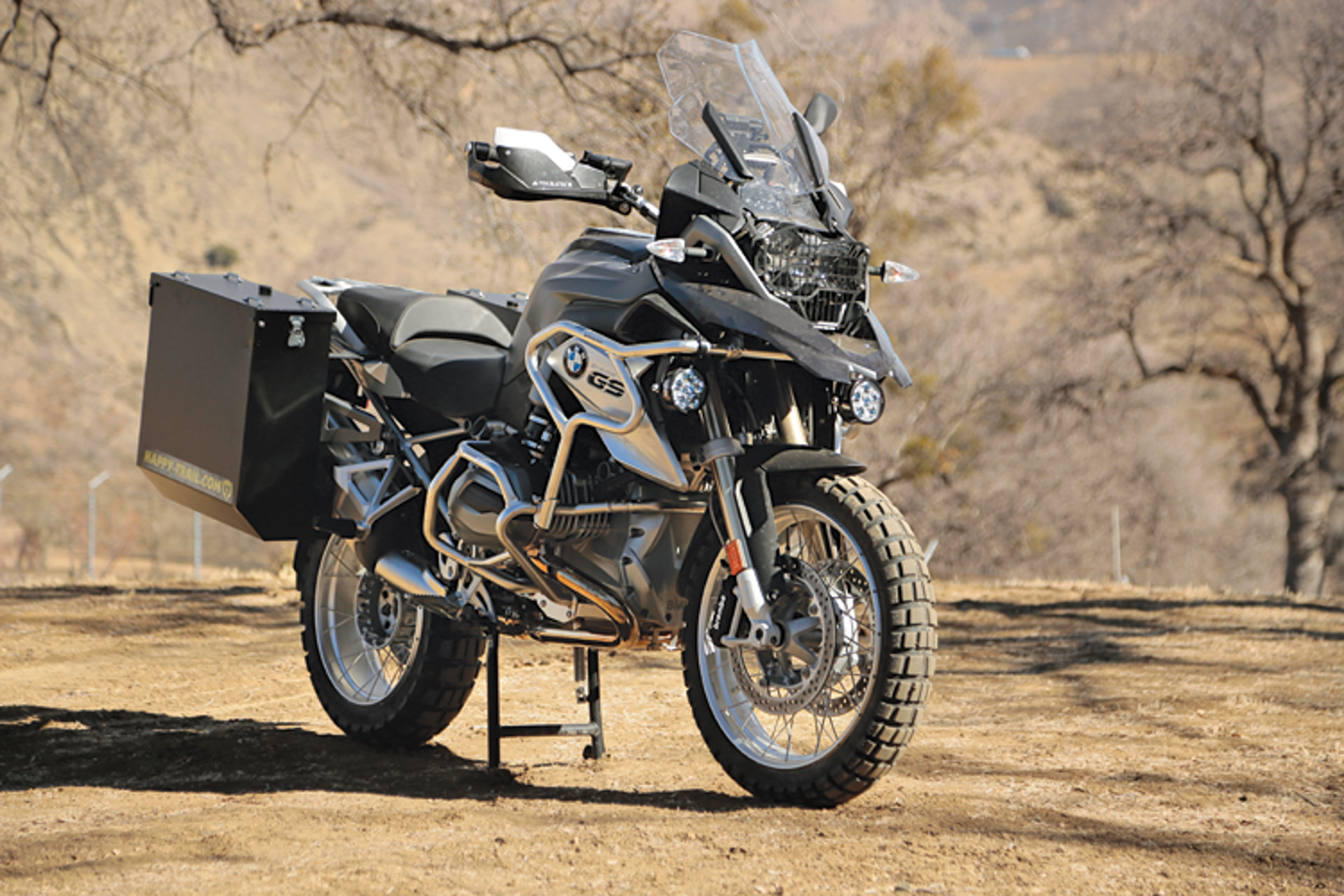
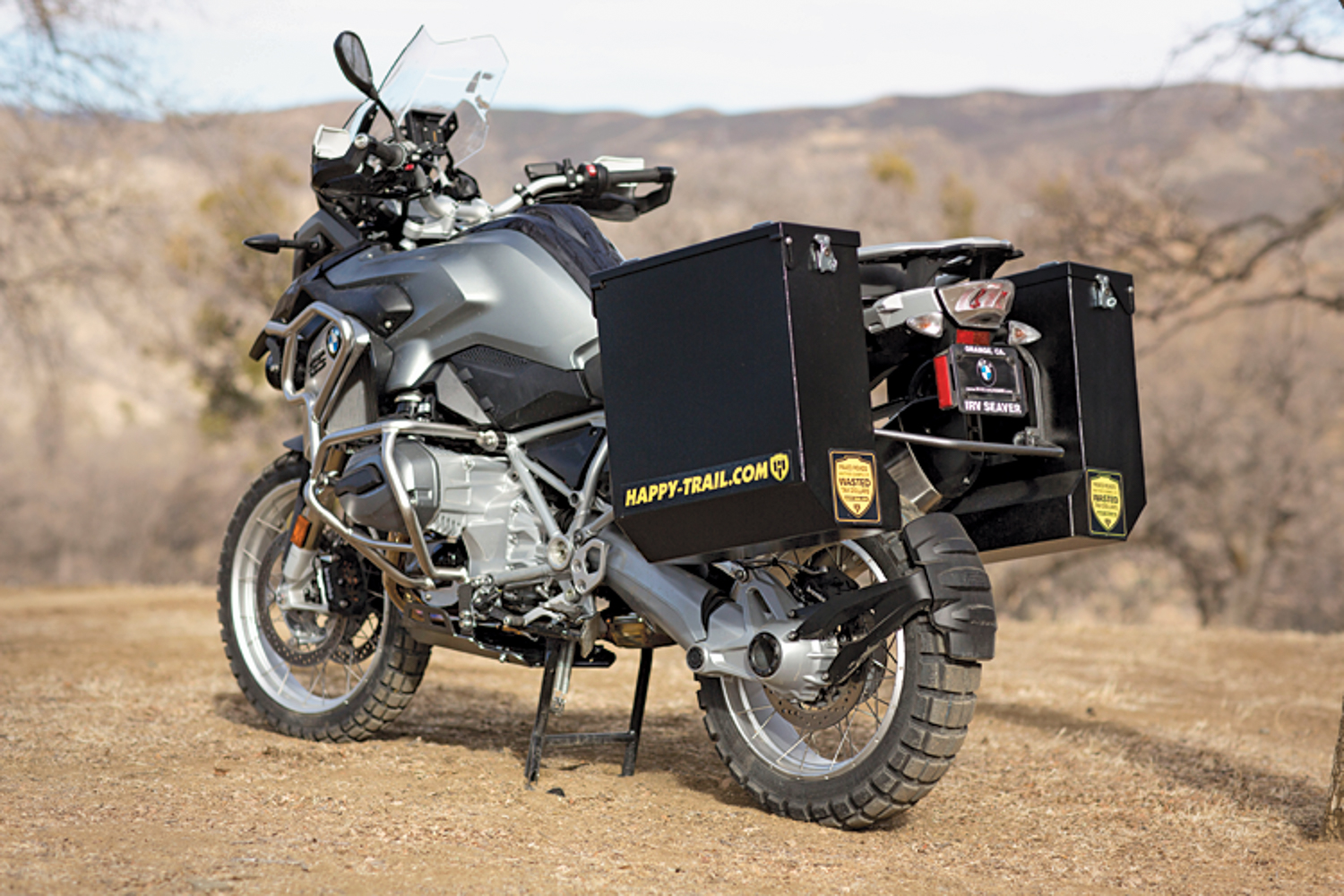
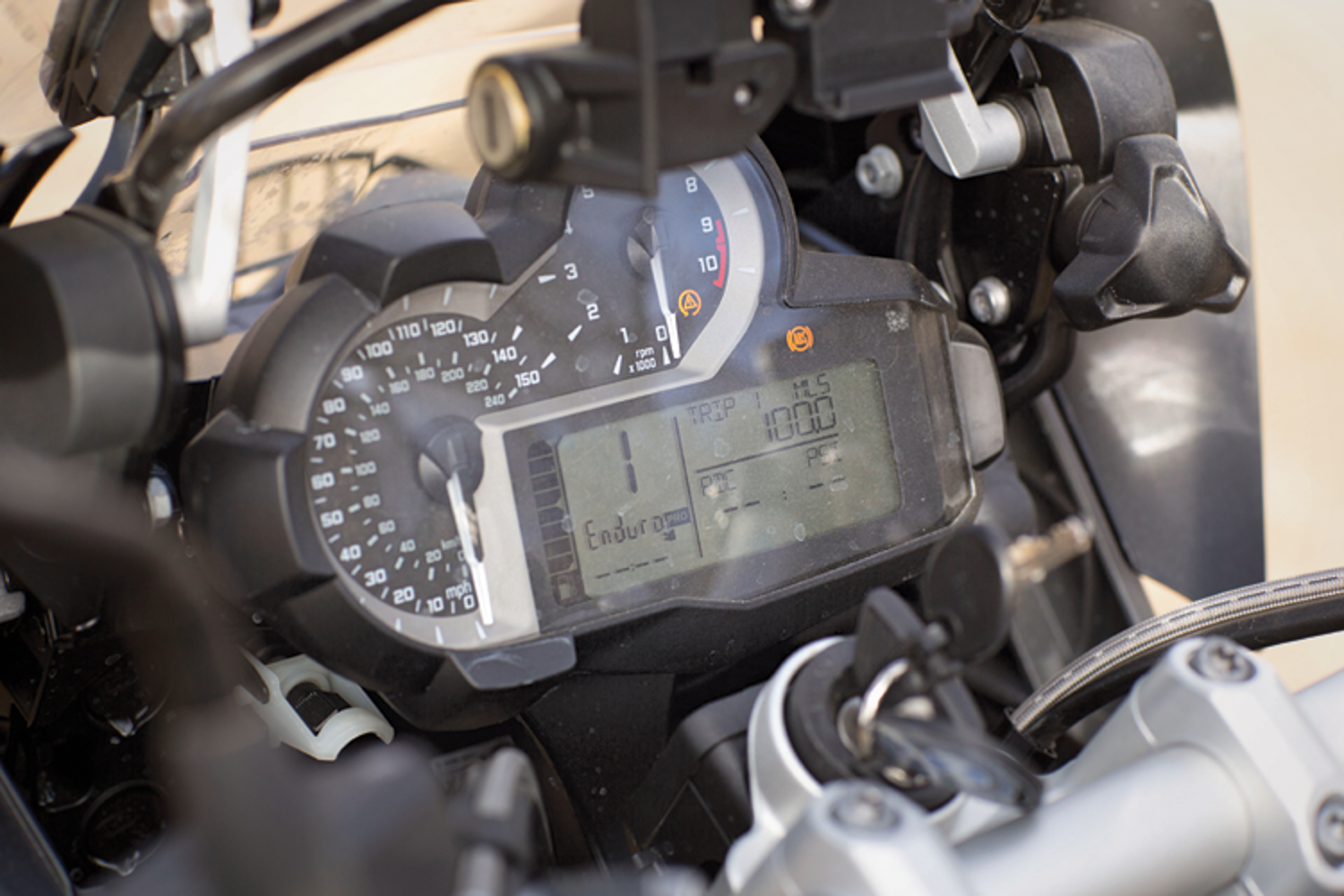
Pros:
• Class-leading refinement, fit, and finish
• All-day rider comfort
• Balanced between dirt capability and touring comfort
• Effective traction control and ABS in all conditions
Cons:
• Head shake, particularly with knobby tires
• Poor instrument readability
• Limited low rpm torque and gearing requires heavy clutch work
KTM 1190 Adventure R $16,799
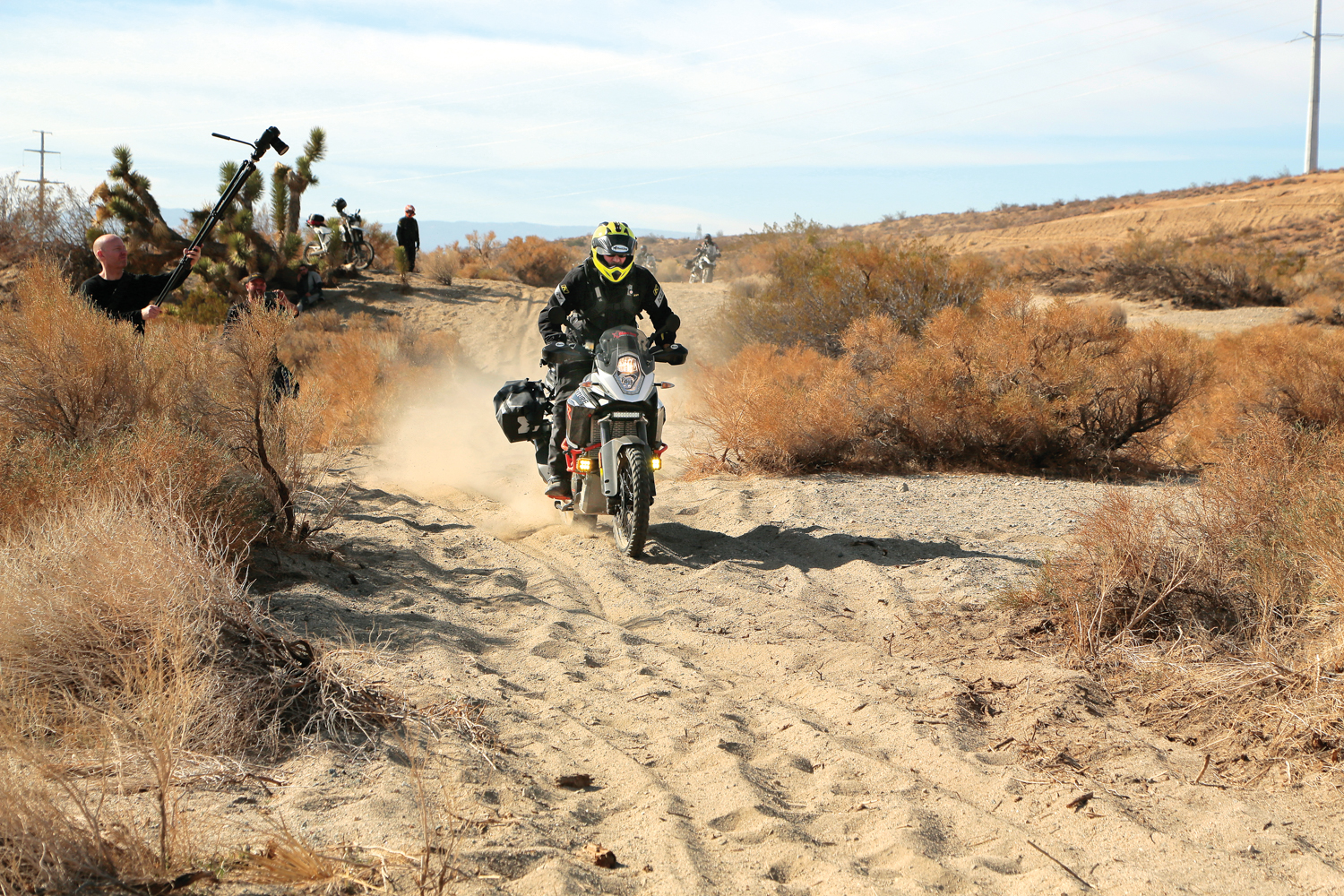
KTM has set the gold standard for dirt-oriented adventure motorcycles since its 1998 launch of the venerated 640 and subsequent 950. These bikes were unapologetic in their intent, which was to maximize technical terrain performance while reserving just enough to allow for stability and basic comfort on the pavement. The new 1190 Adventure R, with its advanced traction control, ABS, Motorcycle Stability Control (MSC), and a 150-horsepower twin, pushes the limits of technology, power, and design, and honors its heritage.
On Road
With the high-revving twin engine launching the bike from 0 to 60 mph in 2.8 seconds (1/4 mile in 10.6 seconds), the KTM 1190 is violently fast. This is nearing superbike territory, and the ample power makes it a thrill to ride from trailhead to trailhead. The redesigned seat is the most notable comfort improvement over the outgoing 990; it’s heaven compared to the previous implement of torture. Despite these improvements, it lacks cruise control, implements a chain for final drive, and ranked in the bottom third of the group for touring comfort. However, we are not interested in the most comfortable bike.
On Trail
The KTM dominated in the dirt. Systems worked in concert to propel the 1190 through sand, up steep climbs, and over rock gardens and ledges like a much smaller bike. The 21-inch front wheel, nearly 9 inches of well-tuned suspension travel, and lighter weight (70 pounds less than the Super Ténéré) allowed it to clear obstacles that knocked other bikes off line. Another improvement is better steering lock for tighter turning. Traction control, which includes Sport, Street, and Offroad modes, is effective and on par with that of the R1200GS, and the ABS Offroad mode provided the best dirt performance. The only annoyance was the need to turn everything off with each key cycle.
With an emphasis on performance and safety, the KTM 1190 Adventure R is exactly what an overland motorcycle should be. It is fast on the road, highly competent in the dirt, and is the first adventure motorcycle with MSC. Though it’s a little unruly on the pavement, the premium suspension, traction control, multi-mode ABS, power, and comfort in the dirt make up for it. Fuel economy was observed at 48 mpg (middle of the pack but an improvement over the 990) and the service interval extended to 9,000-plus miles. It was the highest performing bike in this test and the one most capable of taking on anything adventure travel can send its way.


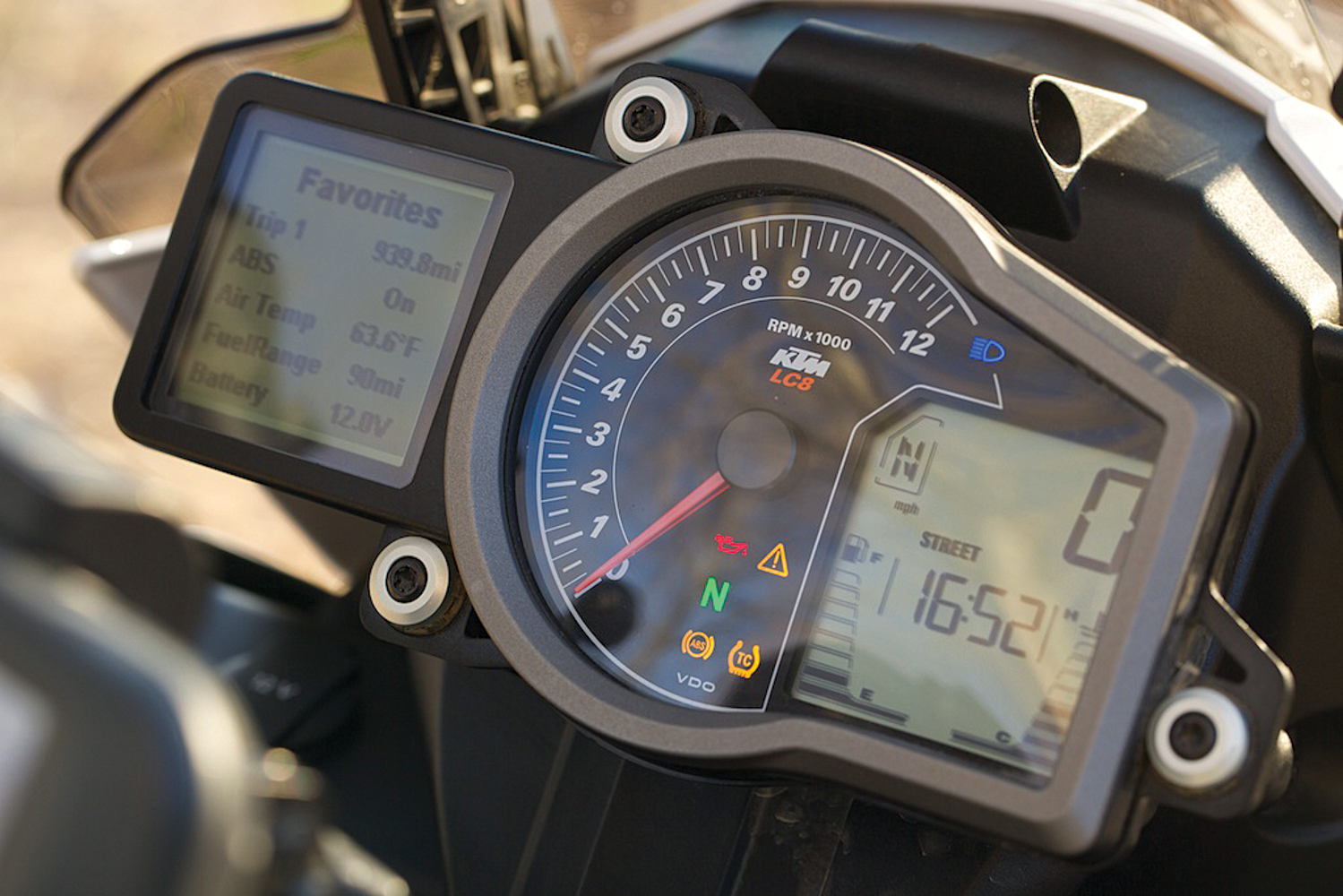
Pros:
• Class-leading dirt performance
• Class-leading street performance
• Class-leading electronics (ABS, MTC, and MSC)
• 21-inch front tire
Cons:
• Lacks touring refinement
• ABS and traction control modes revert when the key is turned off
• Classic KTM rally styling was eliminated
Triumph Tiger 800 XC $11,999
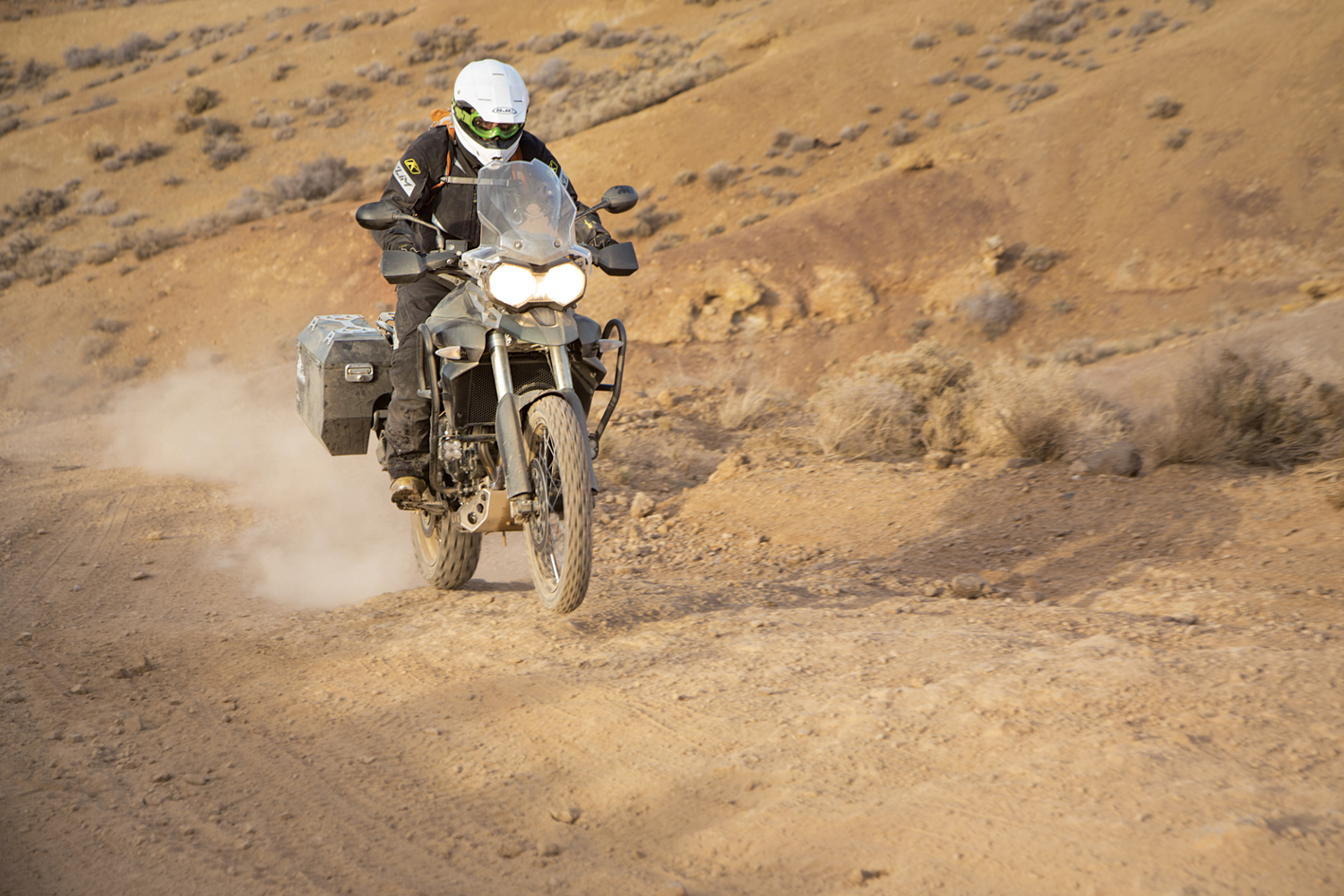
Launching the Tiger 800 XC in 2010, Triumph was a latecomer to the adventure motorcycle segment. It’s a strong performer with a 94-horsepower triple engine, 21-inch front wheel, and 8.7-inches of front suspension travel, combined with a wet clutch and comfortable standing position. The overall design and appearance are modern yet classy, and appealing enough that we chose an 800 XC for our 2014 project bike.
On Road
It is easy to discount the Tiger for compromising on street performance, but the actual experience sings a different tune. It hits 0-60 mph in 3.8 seconds (within a blink of the Super Ténéré and the much more powerful Triumph 1200), and felt more like a supermoto than a dual-sport—it was a blast to ride on the street. I picked up the evaluation bike in Los Angeles and immediately felt confident splitting lanes in rush-hour traffic.
On Trail
I was riding the Tiger when we hit Goler Wash, which has several steep and rocky climbs. It was flawless and fast, maintaining traction and responding quickly to rider input. The suspension is stiff, but I was able to ride at speeds close to that of the KTM. It doesn’t have traction control and disabling the ABS was a quick button push to “off,” a nice feature. Overall the XC was more balanced, more responsive, and soaked up the terrain better than the F800GS. Complaints were limited to touchy throttle modulation and limited low-rpm torque, which necessitated often running it in a lower gear than needed and using more clutch than should have been required. The other negative is the bike’s limited ground clearance and vulnerability of the oil filter. Our test bike took a hit to the skid plate, which in turn dented the filter.
The Triumph 800 XC was one of my favorite motorcycles in the test. It’s fun to ride, genuinely competent on street and trail, and feels lighter than the specifications reveal. Aftermarket support, including a long list of dirt-specific accessories, is extensive and allows for mild-to-wild preparation. The motor is a pleasure to unleash under any conditions, and the bike’s styling, while still unique, reflects aspects of the 1200 Explorer. Despite our extended hard use the bike has proven to be 100 percent reliable. Triumph really nailed this one, and at a hair under $12,000 USD the Tiger 800 XC is an excellent value.
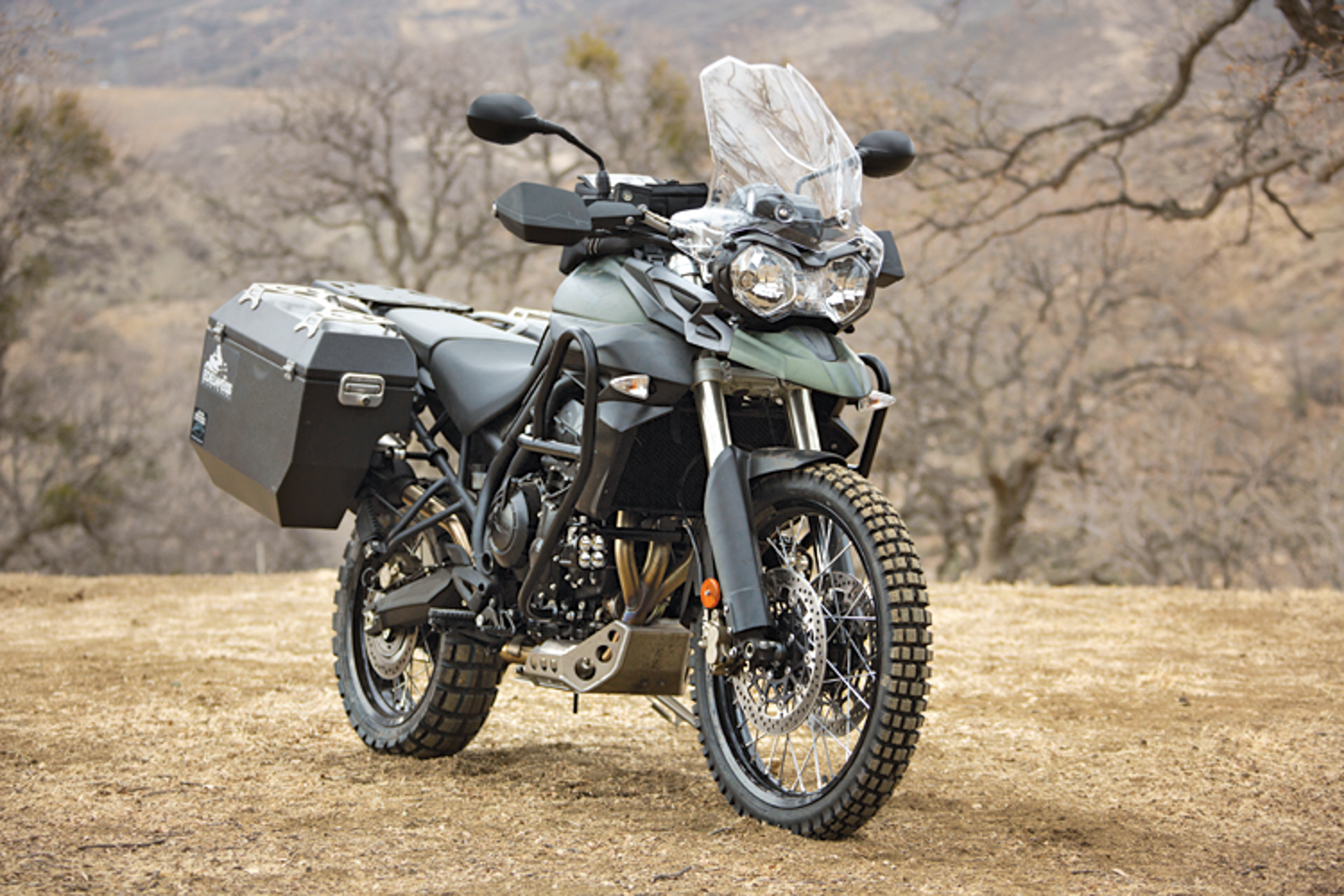
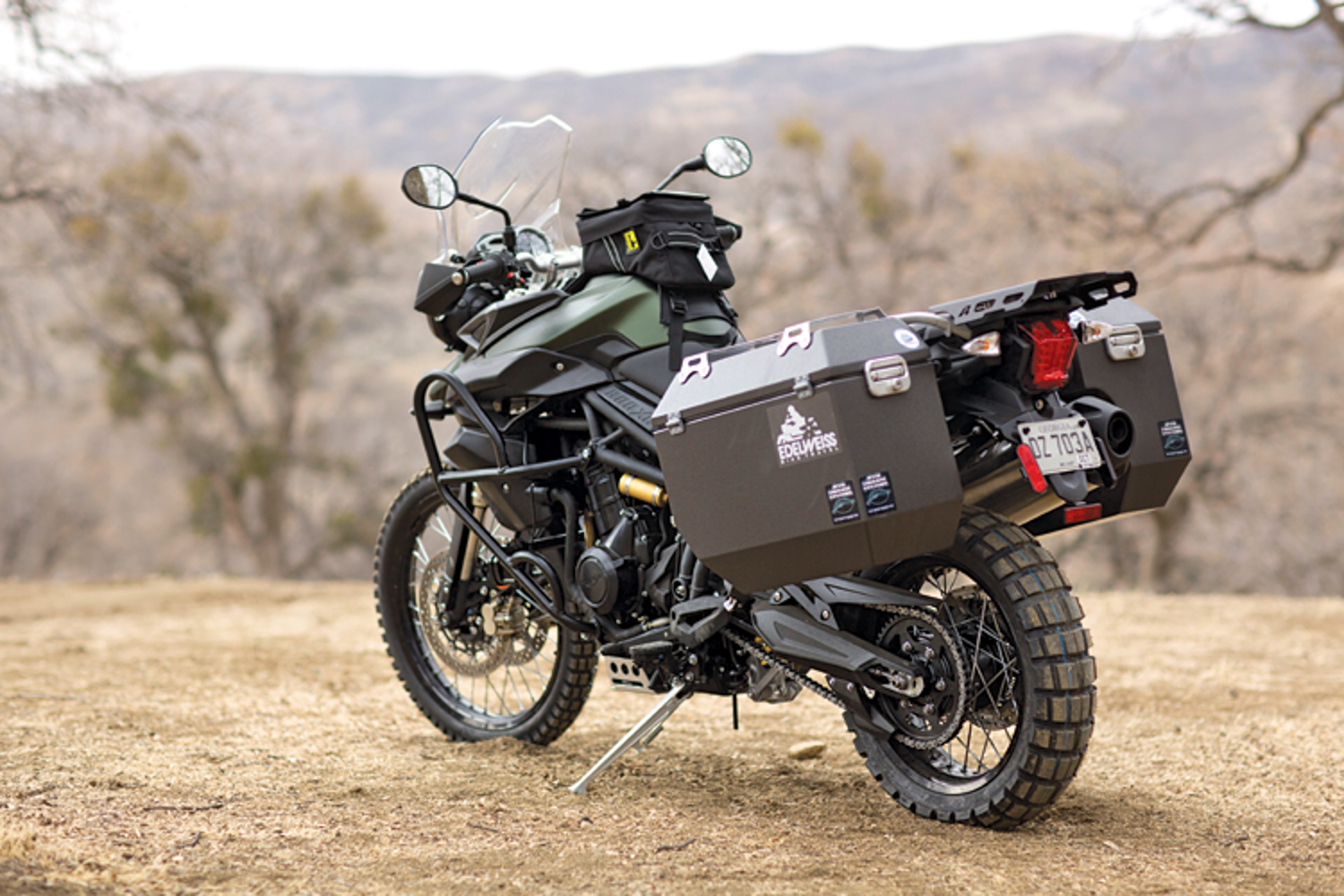

Pros:
• 70 mpg economy with 94 hp
• Strong dirt and highway performance
• 21-inch front wheel
Cons:
• Throttle and clutch modulation difficult
• Limited low-end torque
• Limited ground clearance
Triumph Tiger Explorer 1200 XC $17,199
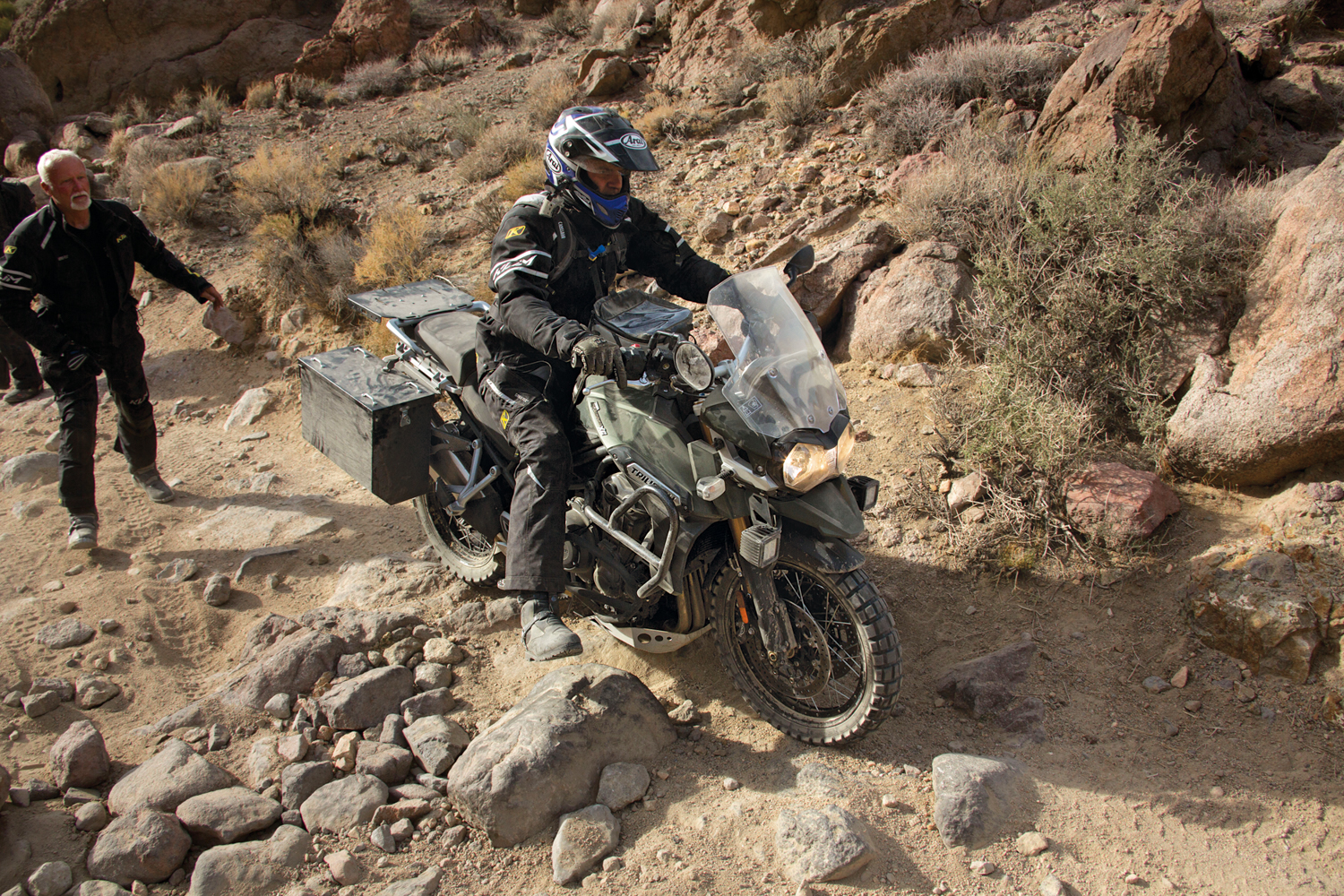
On initial release, the 1200 XC raised more than a few eyebrows, and no doubt caused many a frown in Germany and Austria. It was a promising adventure bike with a 19-inch wire-spoked front wheel, shaft drive, wet clutch, and 135 horsepower.
On Road
The Explorer XC is a road-biased adventure tourer, complete with a wide, dished (and heated) saddle, cruise control, tall windscreen, and a sport-bike rider position. The 1,215cc 3-cylinder motor is smooth and strong, and pulls hard from idle up to the 9,500 rpm redline. An air-cooled alternator provides 950 watts of 12-volt power, enough for even the most gadget-obsessed adventurer. During several months with the Explorer I found it to be comfortable as a commuter with good day-to-day ergonomics. However, on longer trips the high peg position and low seat can put excessive pressure on your lower back. The throttle-by-wire is quite sensitive, which can make modulation difficult. It is better appointed than several bikes in this test, but lacks the refinement and ergonomics of the BMW R1200GS.
On Trail
On the trail, the Explorer XC struggled. It is simply too heavy and soft-sprung to manage technical terrain, and the awkward standing position and touchy throttle further complicate matters. Neither the ABS nor traction control are optimized for dirt, which resulted in leaving both in the “off ” position. The suspension, which was too soft for anything above a crawl, was the greatest disappointment. Shock valving lacks sufficient rebound, which resulted in hard topout and difficulty in maintaining a desired line. With limited ground clearance and a high center of gravity, getting the Explorer through the obstacles of Death Valley was a challenge. It sounds harsh, but the 1200 XC was the worst performer in the dirt.
The Explorer is a beautifully designed motorcycle with a handsome shape and quality materials. It served as a competent commuter and is the bike I chose most days to ride to and from the office. However, as an adventure motorcycle the Explorer is not up to the task, at least not when compared to the others in this review. It has the shortest fuel range, was the least comfortable, and the suspension is too limiting. I genuinely wanted to like the 1200 Explorer XC, but as a first attempt at a full-size adventure tourer they missed the mark. Germany and Austria can rest easy.
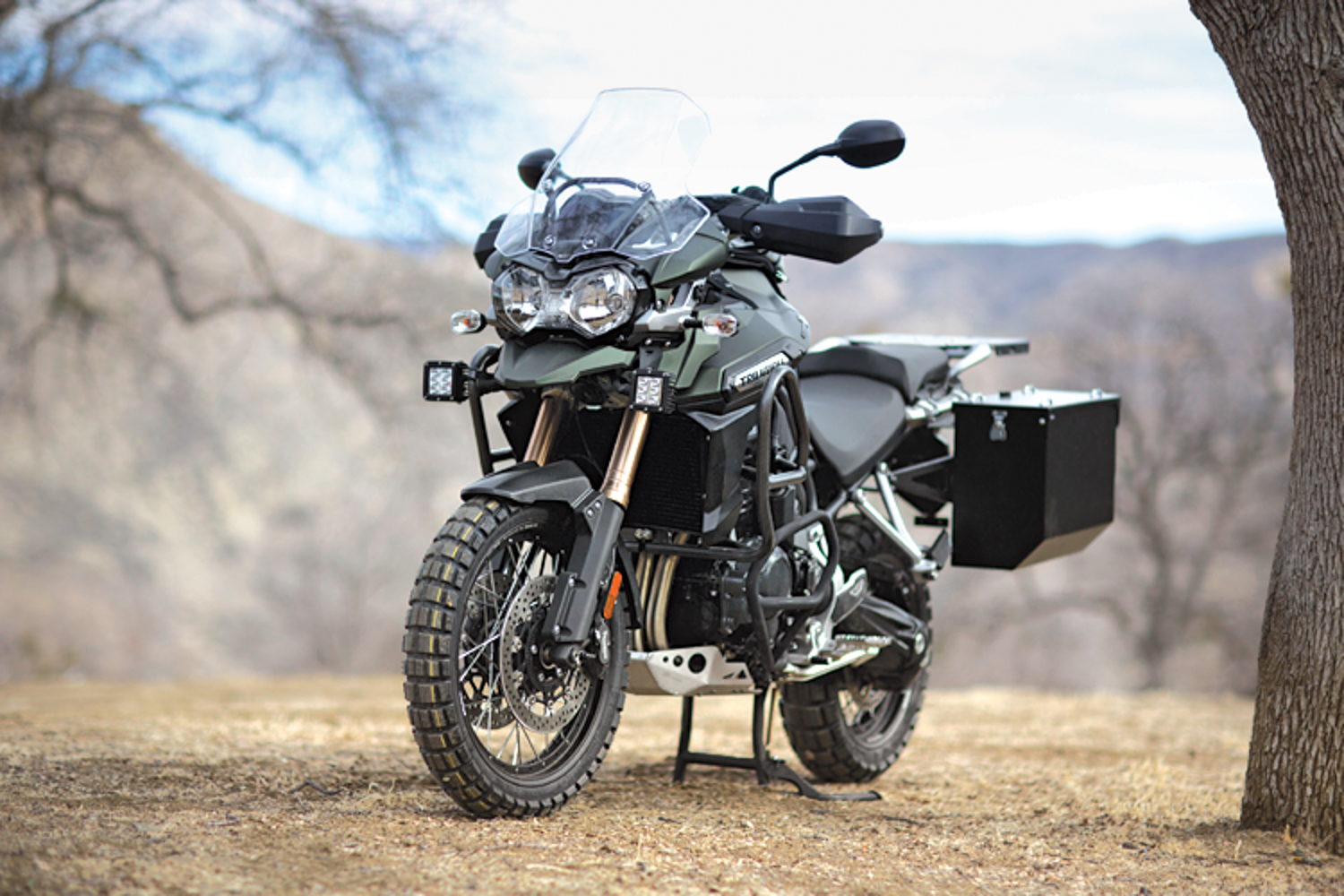
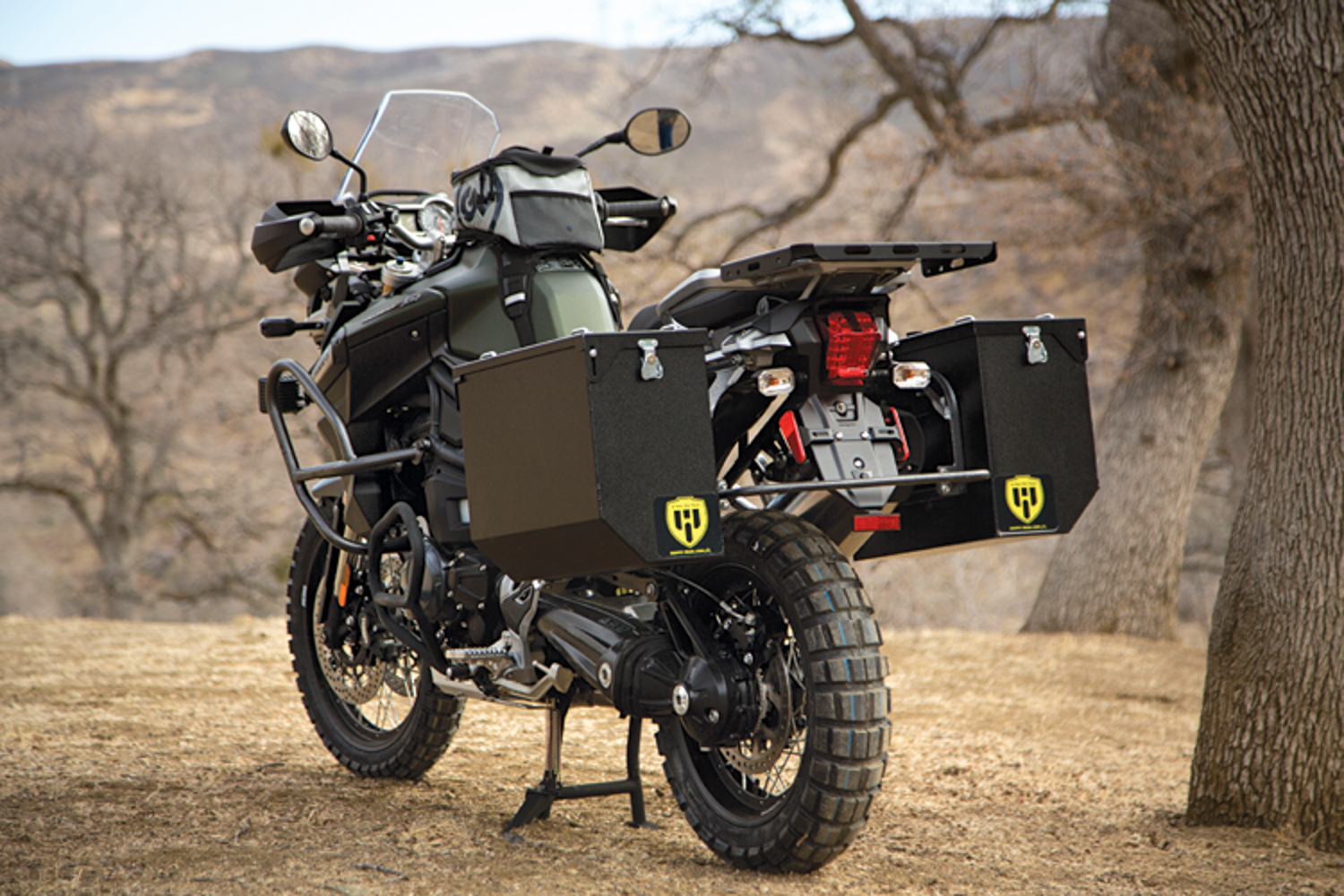
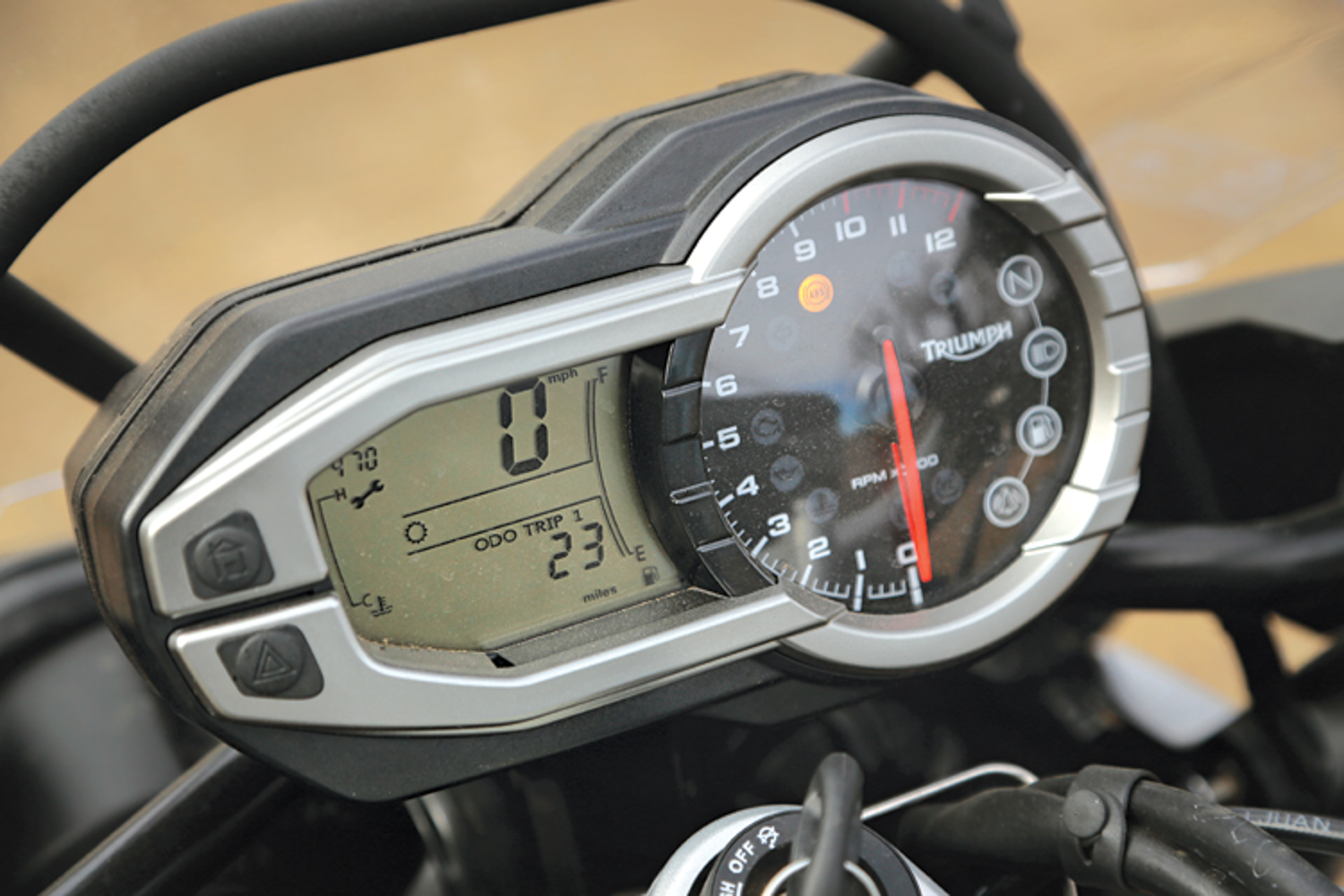
Pros:
• Smooth and powerful 135-hp triple
• Wire-spoke wheels
• Rugged and classic looks
Cons:
• Limited trail performance
• Ergonomics are uncomfortable
• Limited fuel range
Yamaha Super Ténéré $14,790

The Super Ténéré, named after the Ténéré Desert in northern Chad and Niger, is the only Japanese model in this test. It reflects a conservative approach with an emphasis on durability and reliability. The casual observer might consider it the “Land Cruiser” of adventure motorcycles as everything is overbuilt. It gained this reputation, in part, when Jean-Claude Olivier piloted a Ténéré to victory in the 1985 Dakar Rally. From this storied past, Yamaha launched the Super Ténéré in 2010.
On Road
On the highway, the Ténéré is stable; the windscreen offers good protection, and the large, dished saddle is comfortable on long rides. The 1199cc parallel twin’s power curve is linear and provides strong torque throughout the rpm range. Though not nearly as smooth as the other contenders, it has a satisfying pull from deep within the 270-degree crankshaft. The Ténéré feels like a proper adventure motorcycle and behaves like a bike designed for the remote reaches of the planet, where 60 mph is top speed and most of the day is spent dodging potholes and camels.
On Trail
The Ténéré is capable and effective in the dirt, and defies its heft and limited 7.5-inches of travel with a low center of gravity, good balance, and a well-tuned suspension. Ergonomics are excellent. With a small adjustment to the bars I was charging through terrain at speeds nearing that of the KTM and the 800s. Traction control (which can be switched off) allowed some wheel spin and worked well in most terrain. The ABS Offroad is effective but unfortunately cannot be disabled. The YCC-T throttle management is adjustable, and I preferred the smooth modulation of Touring mode (T-mode) in the dirt. One shortfall is that at 578 pounds it is a heavy bike and genuinely struggled in the sand.
I really like the Super Ténéré. Not because it’s the fastest or most capable, but because it is a supremely reliable and durable machine—exactly what we need for remote travel. It is comfortable and stable on the highway, yet capable of handling moderate to technical terrain. The fit and finish is excellent and aftermarket support is extensive. Of the bikes tested, the Super Ténéré had the best balance of durability, reliability, capability, and value. I’m surprised it’s not more popular as an overland platform.
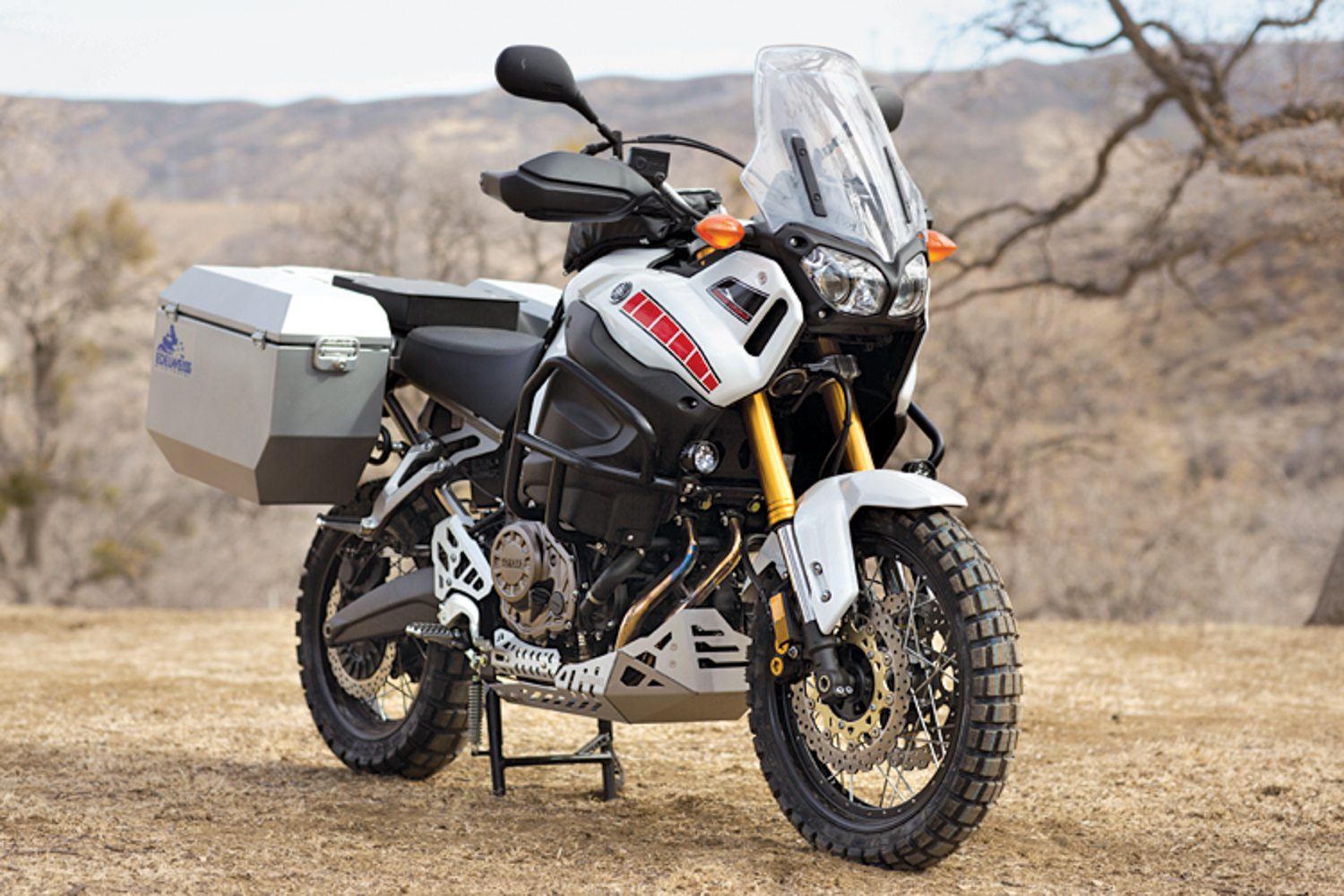
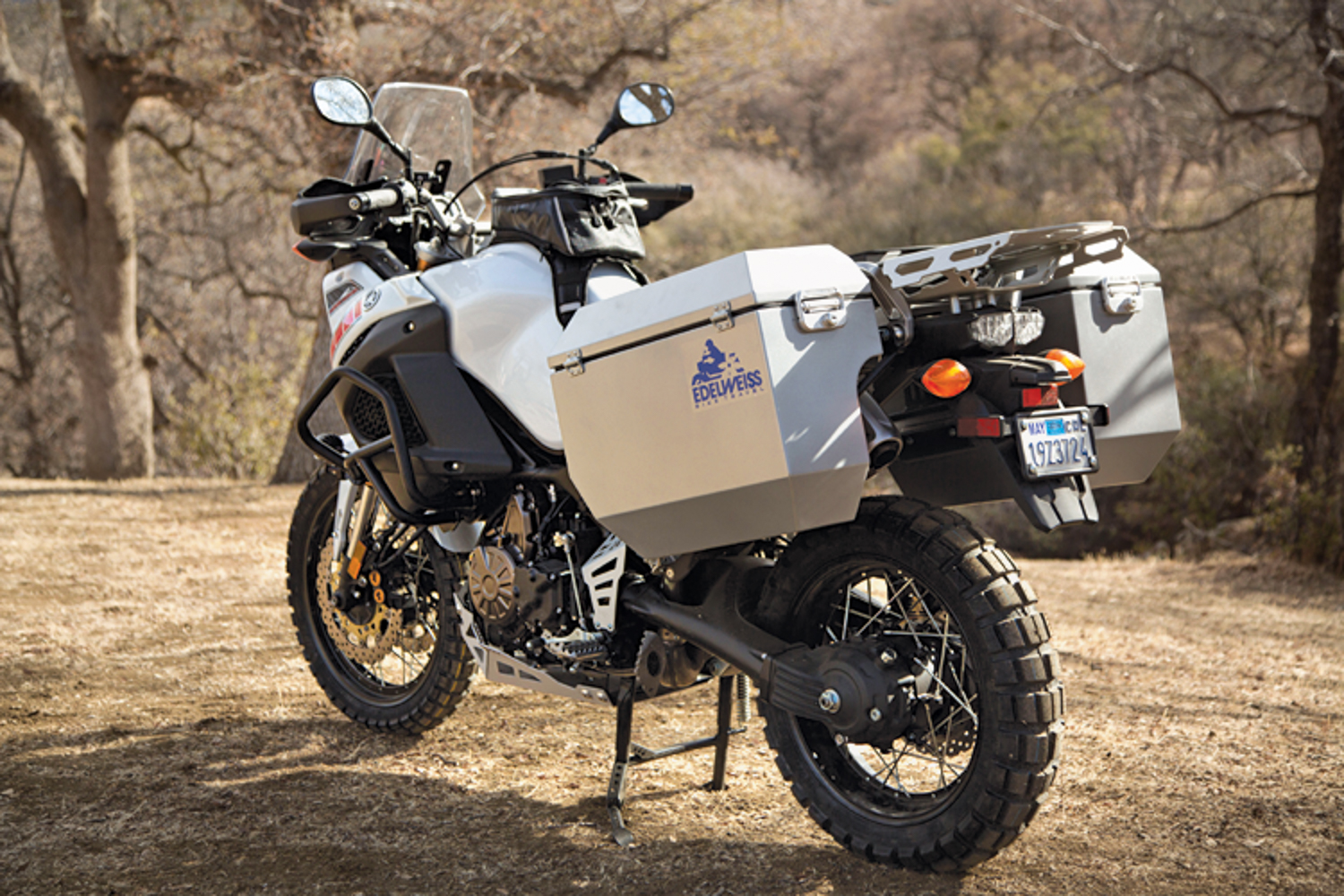

Pros:
• Durable and reliable
• Well-balanced and stable in all conditions
• Strong low-end torque
Cons:
• Lacks “off” position for ABS
• Heaviest model in the test, most noticeably in sand
• Boot clearance aft of pegs is cramped
The 2016 Africa Twin $12,999
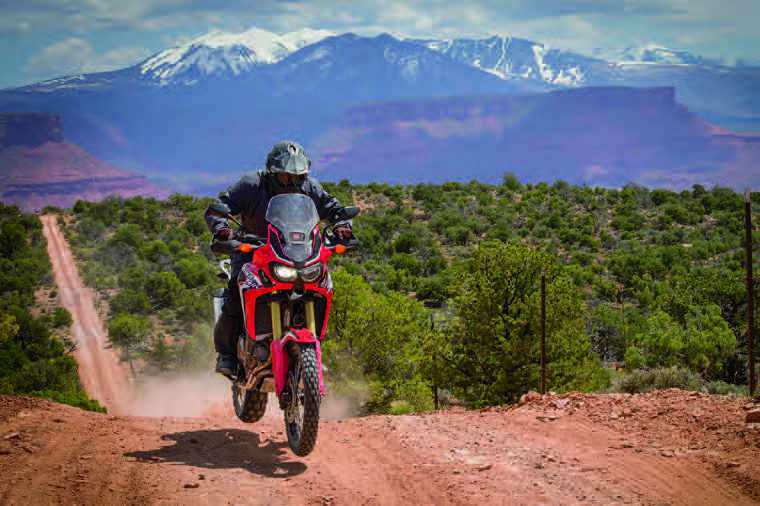 The 1980s were defining for Honda. Stalwart models like the XR600R and the XRV750 Africa Twin won numerous Baja 1000 and Paris-Dakar Rally victories, ushering in over a decade of global powersports domination. Adventure motorcycles were gaining popularity, and Honda’s Transalp XL600V made a short appearance in the United States from 1989 to 1990. Life was good for Big Red, but its ADV glory would slowly fade over the next few decades—until the debut of the CRF1000L.
The 1980s were defining for Honda. Stalwart models like the XR600R and the XRV750 Africa Twin won numerous Baja 1000 and Paris-Dakar Rally victories, ushering in over a decade of global powersports domination. Adventure motorcycles were gaining popularity, and Honda’s Transalp XL600V made a short appearance in the United States from 1989 to 1990. Life was good for Big Red, but its ADV glory would slowly fade over the next few decades—until the debut of the CRF1000L.
The adventure motorcycle community has been waiting for the new Africa Twin; early sketches and teasers have kept forums and blogs reeling with every new detail. Speculation achieved a frenetic pace when a muddied and incomplete prototype graced the stage at the 2014 EICMA show in Milan, Italy. It was clear that Honda was serious about constructing a true adventure machine, but details were veiled. Again, we waited. This changed when I swung a Sidi boot over the new CRF1000L in early May in Moab—a location that would prove to be the perfect testing grounds for the bike.
On the Trail
I will share the good news right off the start—the Africa Twin rips on the dirt. For a 500-pound motorcycle, it rides far lighter and more effectively than its weight or classification would indicate. Most of this is owed to the narrow forward portion of the seat and appropriately sized wheels (21-inch front, 18- inch rear). The suspension is also surprisingly flexible and rewarding in this day of electronic adjustment and automatic load-leveling. After a short trail briefing from Baja 1000 motorcycle champion Johnny Campbell, I removed the rubber peg inserts and rolled the handlebar up to accommodate a more comfortable standing position. As I started the 998cc parallel twin, the motor settled into a smooth idle and a welcome rumble resonated from the exhaust. Throttle modulation was linear and predictable, allowing fine adjustments in concert with the clutch; this was an advantage on Moab’s ledges and slickrock.
Throughout the day, my assessment of the bike kept returning to the confidence it instills in the rider. It was simple to operate yet exceedingly capable; a rare trait in most large adventure motorcycles. Within minutes I was looking for bigger rocks and ledges, pushing the limits of traction and damping. For most of us that ride big bikes, sand is our nemesis—not so with the Africa Twin. It is without question the easiest of the large ADV machines to operate in the sand. I credit this to the combination of its modest weight and 21-inch front wheel. The bike’s geometry is another factor, as the same frame angles that make it stable on the highway also help on low-flotation surfaces.
The suspension is compliant, nearly approaching soft, but the lighter damping is appropriate given the long stroke (230-millimeter front and 220-millimeter rear). Even under significant Gouts at speed, the fork never imparted a hard bottom, remaining stable and predictable. A curious complaint I have read with regard to its 98 horsepower is that it needs more power. This is laughable, and reflects the critics’ limited experience in both dirt and international travel. Even the 162 horsepower of the KTM Super Adventure is electronically limited to (you guessed it) 100 horsepower in dirt modes—nearly the same as the CRF1000L. Power was more than adequate for every scenario we encountered, from gravel roads to slickrock ledges. Another pleasant surprise is the ability to shut off traction control and the rear ABS in the dirt. Don’t worry that the front ABS cannot be disengaged, it is well-tuned and I preferred it to remain on.
On the Road
The CRF1000L is exceedingly comfortable on long stretches of highway; the wide and supportive seat takes pressure off the sit bones while the windscreen all but eliminates buffeting. Although the windscreen is not adjustable, it works well, besting most of the competition.
The motor provides more than enough power for two-up or fully loaded adventuring. At higher speeds, the Africa Twin is smooth and stable, with none of the dreaded wobble or wander, and it pulls strong to well north of triple digits. The bike’s lack of cruise control will contribute to rider fatigue though. One could easily compare the CRF1000L to the larger displacement adventure bikes, but this motorcycle has exactly what we want in a global touring platform.
Conclusion
The 2016 Africa Twin is certainly not perfect, but it does combine several exemplary traits. The first that stands out is Honda’s legacy of reliability and serviceability, something I have experienced from my first dirt bike (an XR250L) to our recent XR650L project. Honda has won dozens of Baja 1000 victories because their bikes don’t quit. As an adventure traveler, I view durability and capability as stalwart attributes, and am happy to give up gadgets and CAN bus wizardry for a machine that will start every time. I cannot overstate how competent the CRF1000L was in the dirt, defying several laws of physics as I tossed it over jumps, ledges, and boulders. What really impressed me though was the $12,999 price tag— that leaves a lot of money for fuel and visas. powersports.honda.com, 866-784-1870
Pros:
• Excellent fit, finish, and materials
• Capable in all types of terrain
• Class-leading in sand
• Price
Cons:
• Limited range with 5-gallon tank
• Gauges are nearly impossible to read while standing
• Additional 23 pounds with dual clutch transmission (DCT)
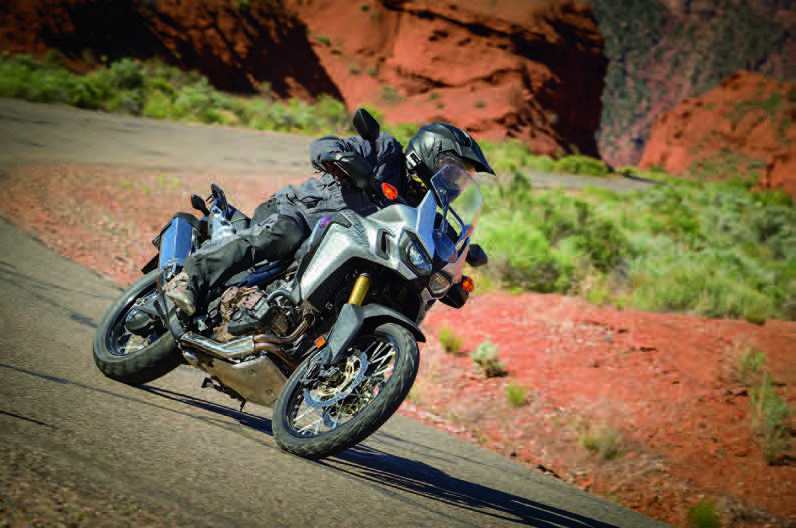 2014 Moto Guzzi Stelvio 1200 NTX $16,000
2014 Moto Guzzi Stelvio 1200 NTX $16,000
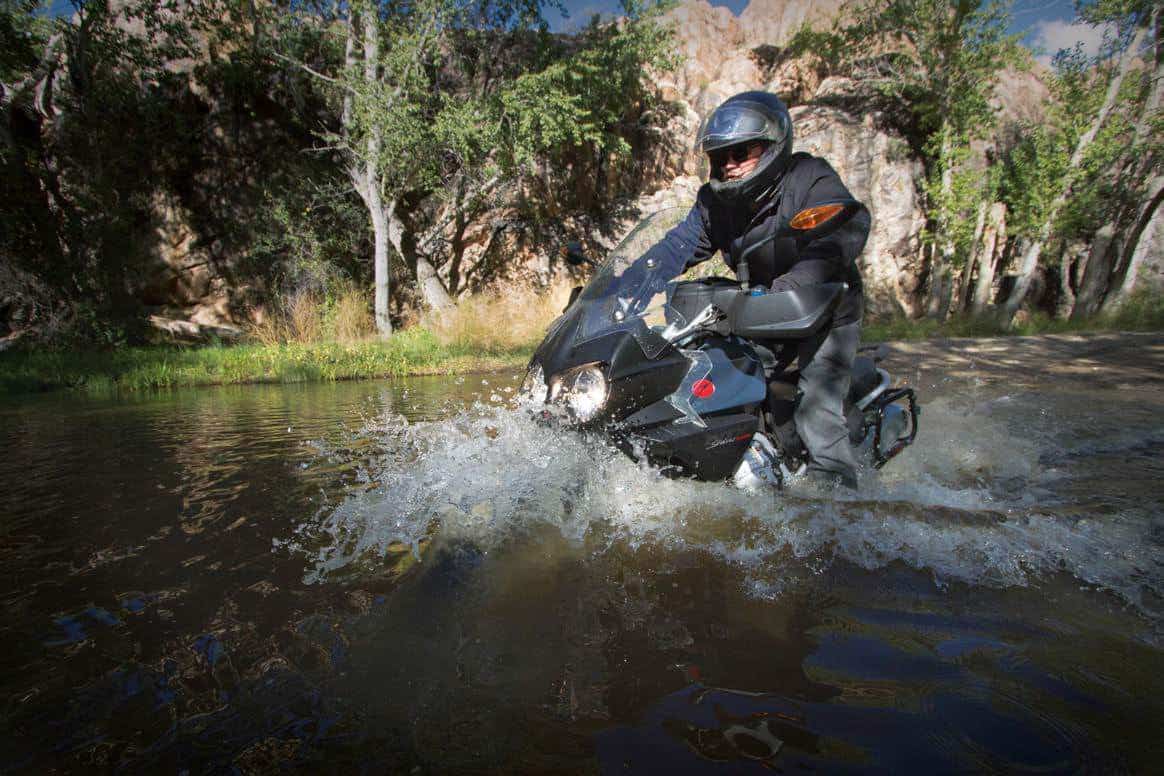
The Moto Guzzi Stelvio, which was named after Stelvio Pass in Northern Italy, one of the greatest riding roads in the world, was introduced in 2008. For 2012, the Stelvio received a major freshening, most notably an increase in fuel capacity to 8.5 gallons—the largest factory tank in the ADV segment. The air/oil cooled 1,151cc V-twin has four valves per cylinder and develops 105 horsepower at 7,250 rpm. While horsepower is adequate, it is the 83 pound-feet of torque (at 5,800 rpm) that is most useful in the dirt or when managing an expedition load through the slow, narrow streets of a third-world country. The engine is simple and has proven to be exceptionally reliable. It starts easily and settles into a heavy rumble, alerting the rider to its displacement. Once underway, the Quattrovalvole has a lustful note on acceleration. Observed fuel economy has been 40 mpg on the highway and about 32 mpg on the trail, thus the need for an oversized fuel tank.
In the Dirt
Off the pavement, our test bike—which was fitted with new Continental TKC 80s and the NTX package—was a pleasant surprise. The NTX option includes an aluminum skid plate, engine guards, Hella lighting, hand guards, and high-quality panniers. These panniers have solid mounting, a quick-detach system, look good, and are thoroughly suitable to dirt travel. Though the pegs come with thick rubber inserts, the inserts can be removed to reveal a reasonably wide, high-traction metal surface. This also lowers the rider position slightly and makes standing easier. On my first off-highway foray I rotated the bars up, which made for semi-comfortable on-the-peg riding. A bar riser would make it perfect and we have since added a Rox 40- millimeter unit, which has greatly improved ergonomics on the trail.
Initial impressions are quite good, particularly for a 600-pound motorcycle. Suspension travel is 6.7 inches in the front and around 6 inches in the rear. The upside down forks are built by Marzocchi and are exceptionally well tuned. I rode this bike hard and never fully utilized all of the available front travel. The structure is rigid and progressive, which allows for subtle damping on gravel roads but a reassuring ramping of both rate and compression valving with big hits. If the rider keeps the Stelvio rolling, its weight is hardly noticeable and on par with other big bikes. It is well balanced, and the bars are wide for leverage. Controls are easy to modulate, though I was gentle (perhaps unnecessarily) on the dry clutch. The ABS is fine on most dirt scenarios, and if needed, is easy to turn off with a single large button on the right switchgear panel (Grazie, Moto Guzzi). In traction control (TC) position one, the TC is pretty useful on gravel roads and in mud. It controls wheel spin and saves the rear tire for more critical moments. TC position two is the most invasive and designed for conditions like rain. Thankfully, TC can also be easily disengaged, even while moving.
I now have two months on the Stelvio and hundreds of dirt miles, including some serious testing at our local proving grounds. In that time I have pushed the bike beyond what 99 percent of owners would ever consider and it never disappointed. I’ve dropped in off of massive granite boulders, jumped it, and rode through hip-deep water. With each new obstacle I gained confidence in the Stelvio and my concern over its weight seemed to fade away. This bike gives little or nothing up to the best of the big bikes and thoroughly trounces some competitors.
On the Road
One of the Stelvio’s strengths is its refined road manners and broad power band. I have found it to be the most comfortable of any bike in the segment. The saddle is wide and supportive with a generous pad and ergonomic shape (at least for my backside). The windscreen is also a pleasant surprise: It is easy to adjust, exceptionally protective, and imparts minimal buffeting.
The cylinder heads do produce a lot of heat, especially on hot days. One midsummer ride from Los Angeles to our office in Arizona (a record heat day) was particularly uncomfortable on the knees and upper thighs. Of course, the warmth will be welcomed during colder months. A few other minor criticisms include the factory mirrors with integrated turn signals. Vibration obscures details, and I found they simply don’t work. They will also be costly to replace if (when) the bike is dropped. Cruise control would be nice, but is unfortunately not available. I also noted that the heated grips were warm, but off the mark compared to other models.
The Guzzi is a comfortable adventure tourer, and I have enjoyed 8- to 10-hour saddle days without much complaint. Once the road gets twisty, the well-tuned suspension and torque from the big twin does not disappoint. I have ridden this bike nearly daily for the past 2 months and we are getting along fantastico. So far the Stelvio has been reliable, but we need more miles to weigh in on its ultimate durability. With a retail price of less than $16,000 with all the goodies (almost $9,000 less than a similarly equipped BMW R1200GS Adventure), the Stelvio is an excellent value. Future plans include a weeklong dirt trip through Southern Utah, where I can push the Guzzi even further afield and into more technical terrain. In the meantime, I am going to fire up that magical Quattrovalvole. Ciao! motoguzzi-us.com, 877-696-6864
Pros:
• Supreme road comfort, wide saddle, and big windscreen
• 8.5-gallon fuel tank
• NTX package with quality luggage and crash protection
• Genuine value given the features and overall performance
Cons:
• Weight (especially with full tank)
• Mirrors are not appropriate to motorcycle
• Fuel economy lags industry
Aprilia Caponord Rally $16,499

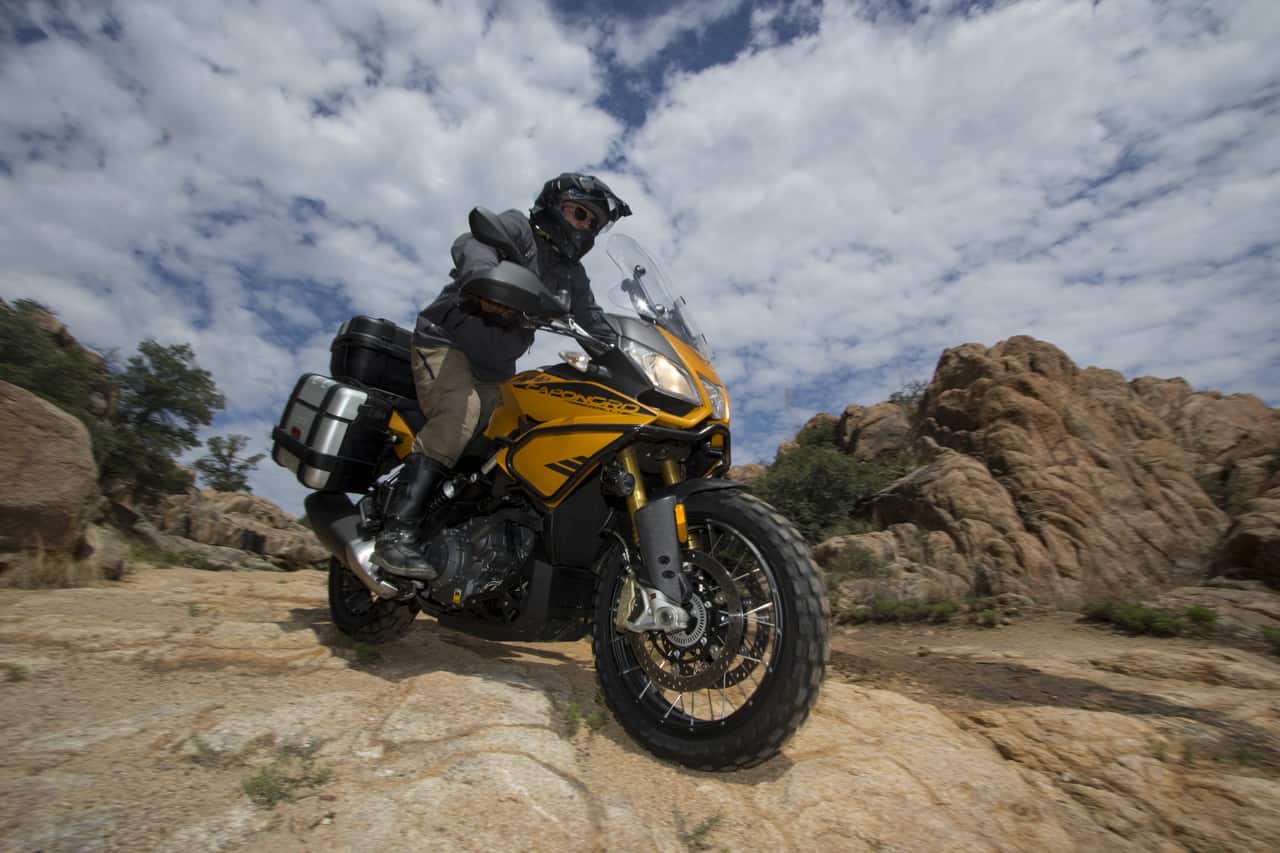
Founded in the province of Venice, Aprilia started out by making bicycles after World War II; by the late 1960s, they were producing motorcycles. In typical Italian fashion, they manufacture models with a deep emphasis on design and performance. This enthusiasm continues to the track, where they are the world’s most successful racing brand with 54 world championship titles and 294 MotoGP wins. All of this translates into a uniquely capable and spirited adventure motorcycle with the Caponord 1200 Rally.
As a touring and adventure machine, the Rally feels built for travel, a reflection of the long wheelbase, comfortable saddle (even for the pillion), large adjustable windscreen, and upright seating position. Standard equipment reads more like a luxury sedan than a motorcycle, providing two-channel ABS, three-mode traction control, dynamic damping with electronically adjustable preload, cruise control, and a full complement of LED lighting. With the factory Metzeler road-biased tires and healthy 125 horsepower, all conceivable speeds are possible, whether the road is straight or wondrously curved. The Caponord also comes with aluminum-skinned side bags that open with the ignition key, and the available top case can swallow a 12-inch pizza box. When compared to other options in the segment, the $16,499 retail price feels like a bargain.
On the dirt
The Rally exceeded my expectations, but I did find a few useful adjustments that significantly improved performance. Most important was the installation of a more trail-biased tire, fitting a TKC80 to the 19-inch front wheel and a TKC70 to the rear. This immediately changed the stability of the motorcycle in loose conditions and even enhanced the effectiveness of the traction control (which can also be turned off). The second change was to run the suspension in maximum preload (set to two riders, plus luggage) anytime I was on an unmaintained road. This increased ground clearance and stiffened the spring rate and shock valving.
There are a few limitations when compared with other available models, most notably the lack of a real skid plate (it is plastic) and any true enduro-tuned traction control or ABS modes. Despite this, I did push the Rally well beyond typical use, and found it to be fun and tractable when supported with good riding technique. I also noted the brake, clutch, and throttle modulation to be light and highly controllable, and the 504-pound dry weight to be a welcome relief compared to most 1200s.
The popularity and growth of the adventure motorcycle market have brought about a cadre of new contenders, some from the most unlikely of manufacturers. However, Aprilia is actually a perfect breeding ground for such a motorcycle, combining their performance-oriented engineering and decades of dirt bike success (including nine world off-road titles). The Caponord is an extremely fun and engaging bike to ride, the throaty exhaust barking under hard acceleration, the front wheel fighting gravity. I leave the 6-gallon tank full and often find myself grabbing the keys—there are always roads to explore. aprilia.com, 877-462-7745
Pros:
• Wonderful touring machine
• Strong, performance-oriented motor
• Excellent ride quality and stability
• Good value
Cons:
• Plastic skid plate
• Limited range
• Traction control and ABS only street tuned
• Limited aftermarket support
Conclusions
I believe this evaluation, which included 16 different assessments over an 18-month period, allowed for all attributes of a legitimate dual-sport to be analyzed. Units were tested in stock form as well as with nearly identical modified configurations (there were small variations in skid plate manufacture and tire type due to size constraints). However, despite these controls, motorcycle comparisons are highly subjective, and it is important to understand expectations. While I have noted on-road comfort, these impressions had limited weight on my final conclusions.
On Road
On the highway the BMW R1200GS, with its wide seat, cruise control, and adjustable windscreen, is the most comfortable and refined, followed shortly by the Caponord. If your travels are primarily on pavement the BMW 1200 is an easy choice. The KTM is also class-leading on pavement, but for different reasons—the superbike go-to-jail-or-the-hospital kind of reasons. However, what is most notable about the KTM is the marked improvement as a touring motorcycle over the outgoing 990. With the exception of the 1200GS and Triumph Tiger 800 XC (my third favorite), the other motorcycles are just average. The Tiger 800 XC is fast, nimble, and demonstrated the best fuel economy of the group. The BMW F800GS was the least comfortable on the pavement and suffered from noticeable head shake.
On Trail
Dirt performance was heavily weighted, as I believe an adventure motorcycle should perform well on pavement and in technical terrain. Though the advantage of a larger bike is on-road comfort and performance, if a rocky river crossing in Copper Canyon, Mexico, or muddy bypass in Nicaragua is in your future, you’ll need something more.
Throughout the test, it was clear that the KTM 1190 Adventure R would likely be the dirt champion. It not only works in everything from deep sand to single tracks, but does it with less effort, more speed, and greater control. The standing position is comfortable, and the bike feels light and responsive. It takes some work to bottom the suspension, which usually happens only after several feet of air under the tires have been achieved. I cannot overstate the effectiveness of this motorcycle, particularly in scenarios an overlander will encounter. A close second is the Honda Africa Twin, which can nearly pace the KTM, but lacks the more planted feel and responsive drivetrain. A close third is the Triumph Tiger 800 XC. My complaint with the 800 XC is its limited ground clearance, lack of low end torque, and difficult throttle modulation.
I would rank the BMW F800GS as only a fair performer on the trail. Part of this is due to its odd weight distribution, but it received the greatest deduction in stature due to its poor long-term reliability and the fact that it has been recalled more than a Corvair. Its older brethren, the R1200GS performed much better than expected for a bike of its size and weight. It is correctly balanced, has well-tuned traction control and ABS systems, and has proven durable—our water-cooled test units endured tank-deep water crossings and big air from our evaluation team.
The Yamaha Ténéré makes good on its namesake in everything from rock gardens to rutted climbs—save deep sand. I rode the Ténéré on single tracks, drifted it on gravel roads, and generally treated it like a dirt bike. It never complained. The Triumph Tiger Explorer 1200 XC is simply outgunned in the dirt. The suspension travel is too short, valving too soft, ground clearance too low, and the center of gravity too high. If heading to Ushuaia I’d not veer far off the Pan-American with this one. The Caponord Rally and Stelvio are both better on the dirt than most owners will realize, but their intended use is primarily pavement and gravel road touring. The Rally is limited by a lack of real skid plate and the Stelvio constrained by the weight.
The reliability and performance of each new generation of adventure motorcycles have continued to improve; a trend I appreciate as a long-distance overlander. However, I encourage each of these companies to remember that it is the all-terrain performance that makes a motorcycle suitable for adventure. Making a bike a better touring platform is the easy part, but ensuring that the motorcycle also performs on remote tracks of the back of beyond is what makes this reviewer and Overland Journal readers nod in approval. With this test concluded, I would gladly ride any of these motorcycles around the world. However, if I had to grab the keys to one for an around-the-world jaunt, it would likely be the BMW 1200 GS… with some knobbies of course.
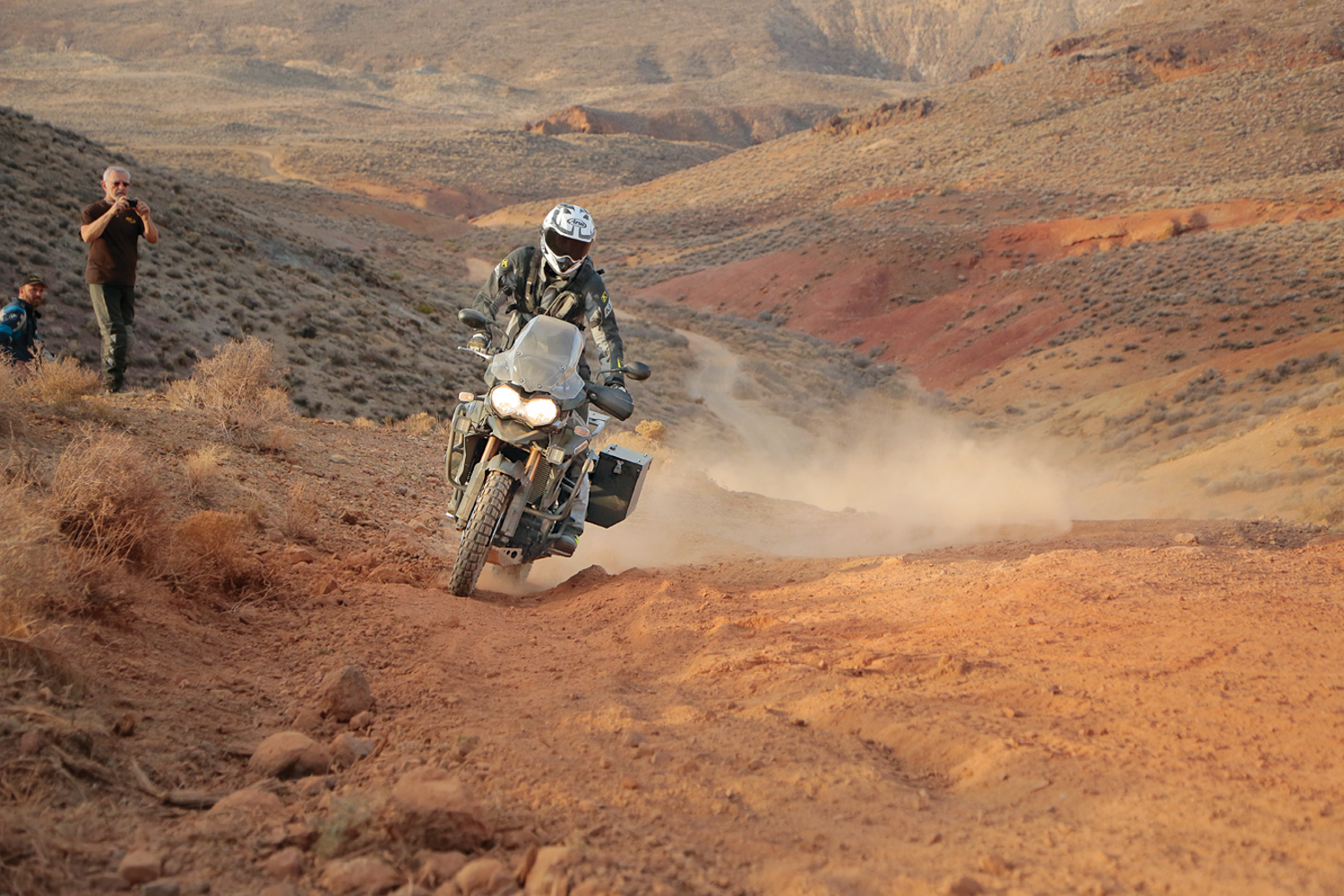


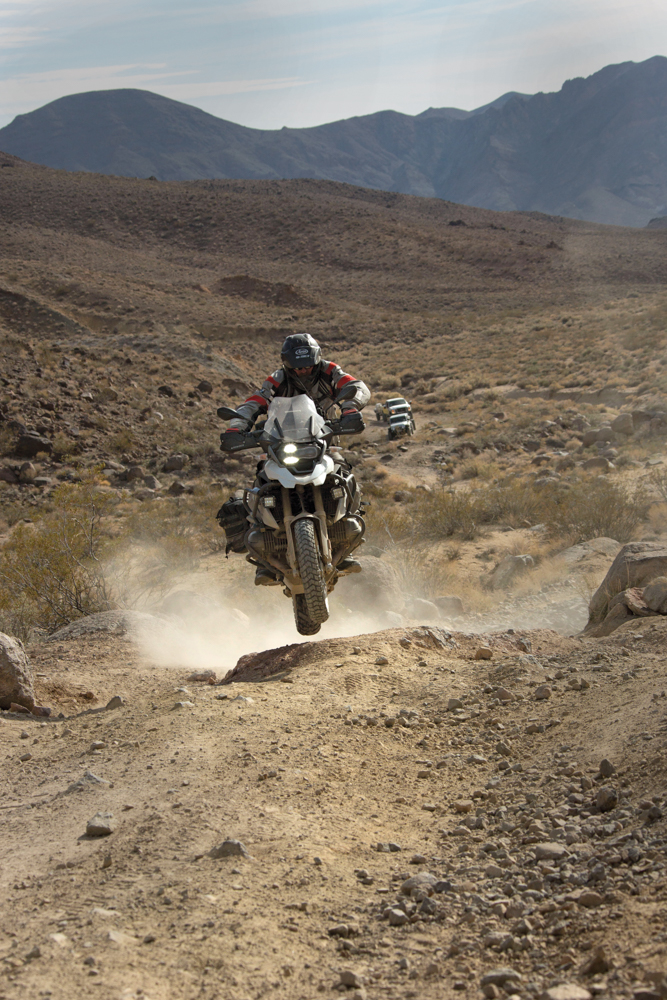






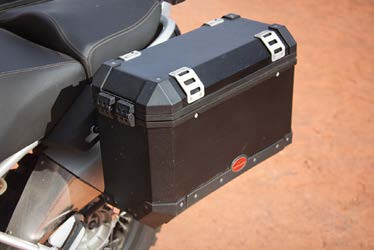

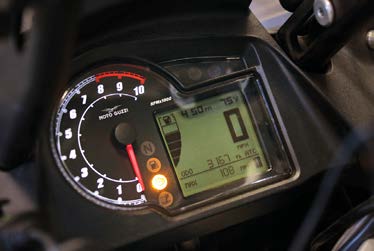


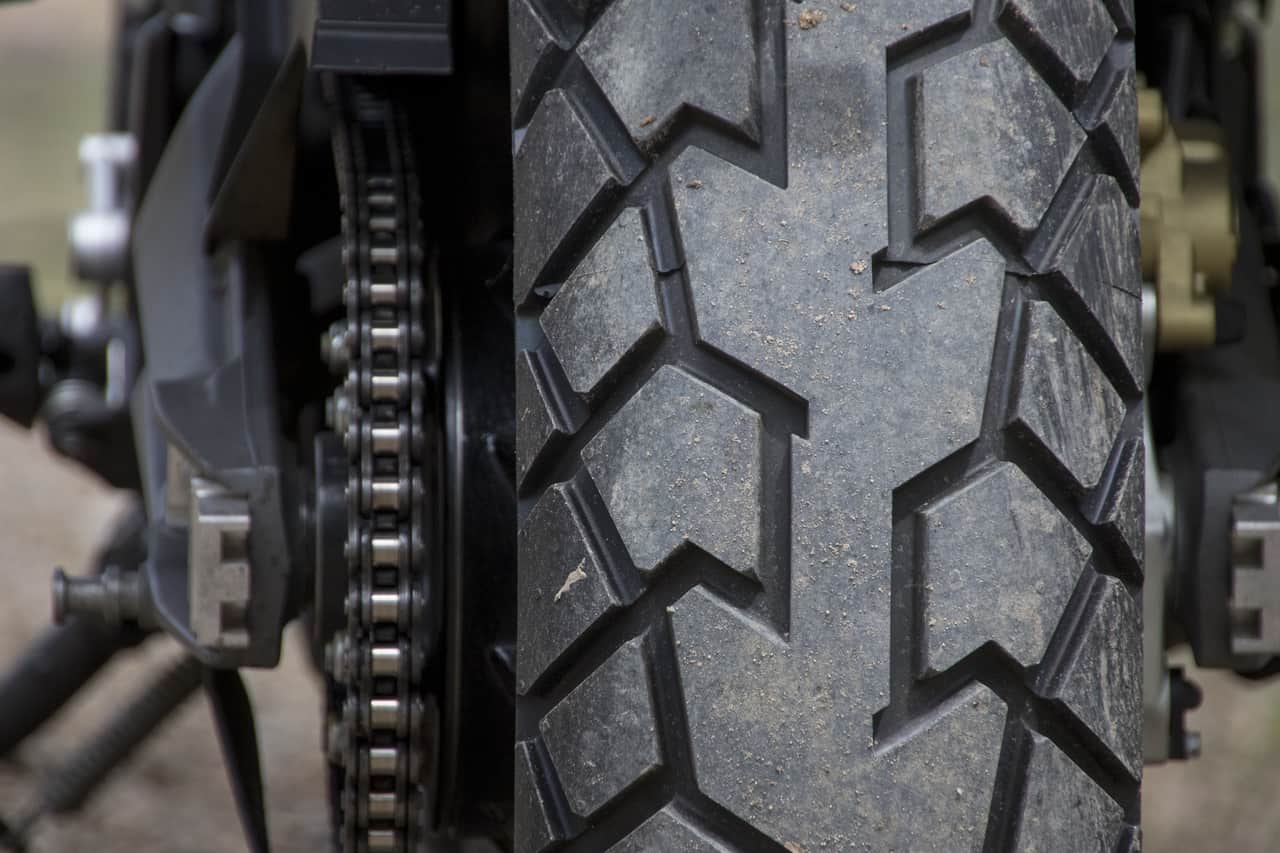
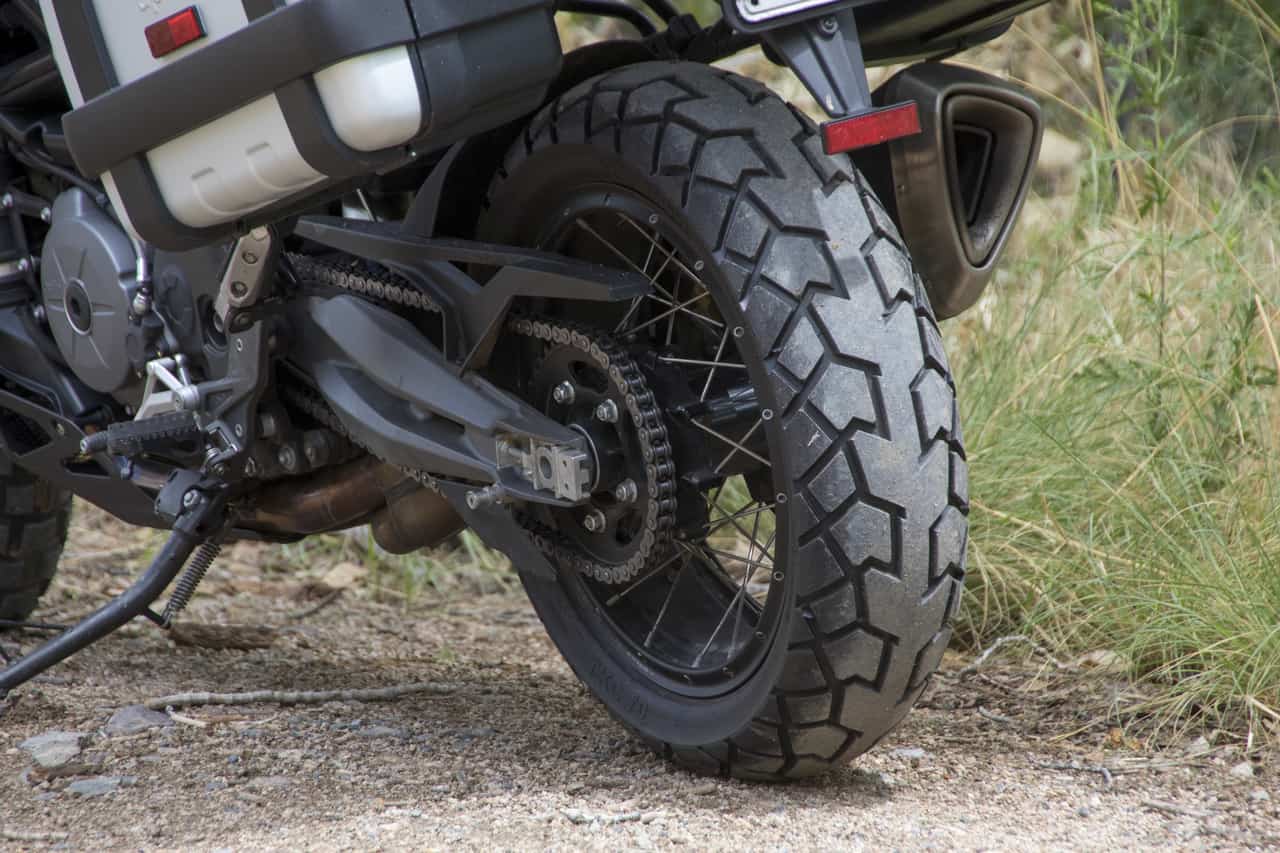

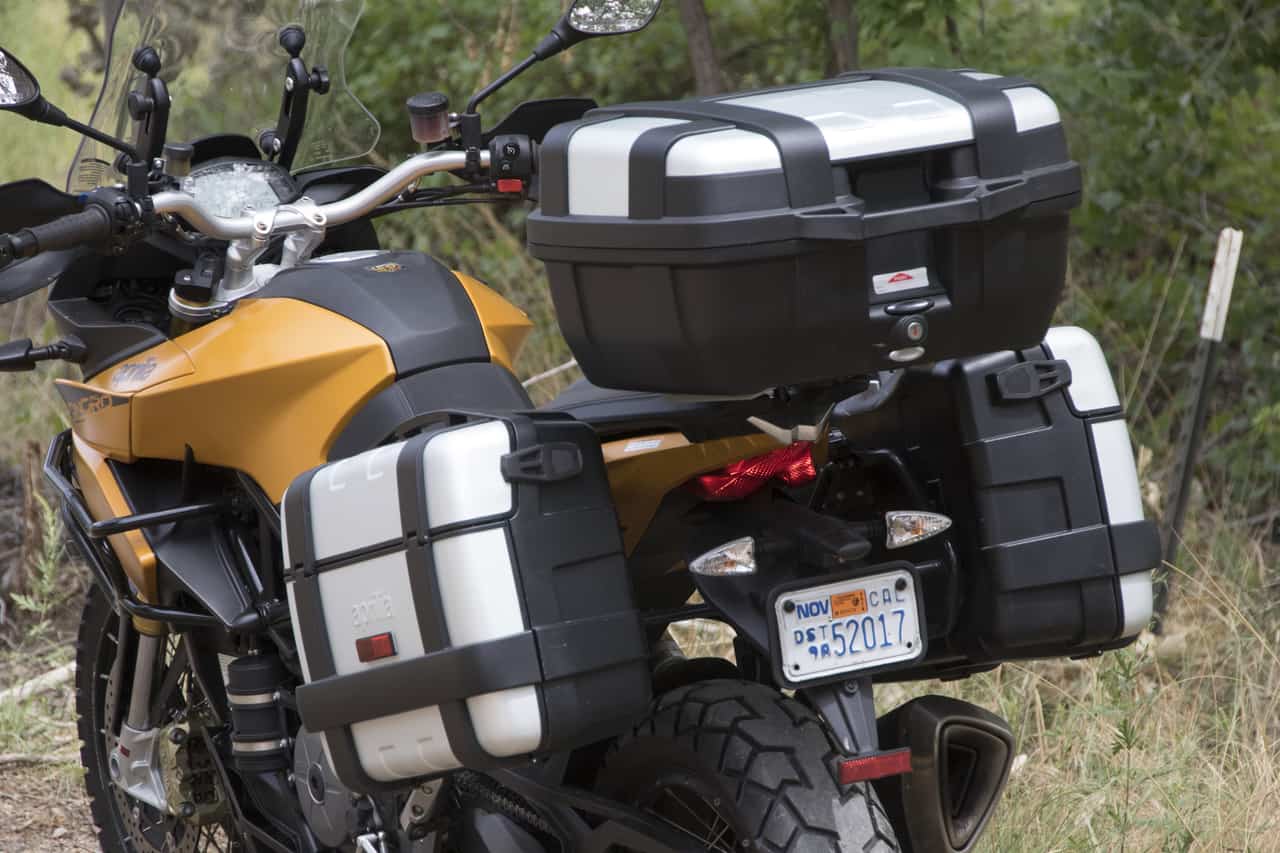



One Comment
JAMES POTTER
January 28th, 2019 at 8:58 am“The Super Ténéré, named after the Ténéré Desert in northern Chad and Niger, is the only Japanese model in this test.”
The next bike in the test is a HONDA Africa Twin. From Japan. Am I missing something?